This website uses cookies to improve your browsing experience and analyze the use of the website. Learn More

Reserve Your Spot with Confidence! Full Refunds with 24 Hrs Notice. Reschedule at any point, even after tour, if space allows!

Jackson Square New Orleans

This post is a self-guided tour of things to see and do in Jackson Square, a National Historic Landmark in the heart of New Orleans' French Quarter.
In this post, we address food, lodgings, entertainment, and other activities available in the Square, as well as a short self-guided tour.
- What is Jackson Square?
Where to Eat & Drink
- Self-Guided Tour
- Weddings + Events
Art, Music, & Magic
- Things to Do in NOLA
WHAT IS JACKSON SQUARE?
Jackson Square is covered on our daily, pay-what-you-like tours of the French Quarter .
Located right across the street from St. Louis Cathedral and steps away from the Mississippi River, this square and its central monument, have become one of the most popular places for tourists to take a selfie in New Orleans.
In addition to providing an excellent photo opportunity, this location is also one of the most popular parks in the city.
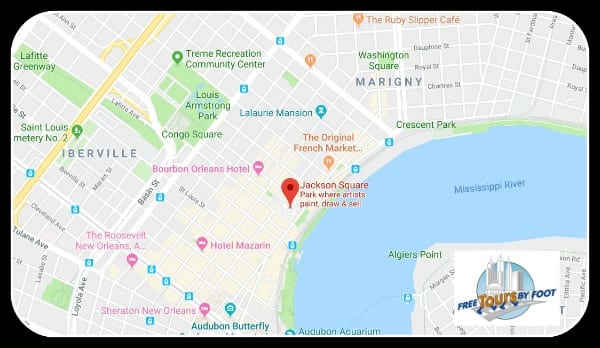
Most people walk here, but both the streetcar and a couple of bus lines run nearby.
However you decide to get here, we recommend using this Google Maps link for directions here .
Jackson Square is a square with several walkways that meander through formal gardens and a black iron fence encasing the square.
The park is named in honor of General Andrew Jackson. His equestrian statue in the middle of the park was erected in 1856.
The choice of General Jackson related not to his presidency, but to his local claim to fame – his leadership as a Major General in the Battle of New Orleans, the final battle in the War of 1812.
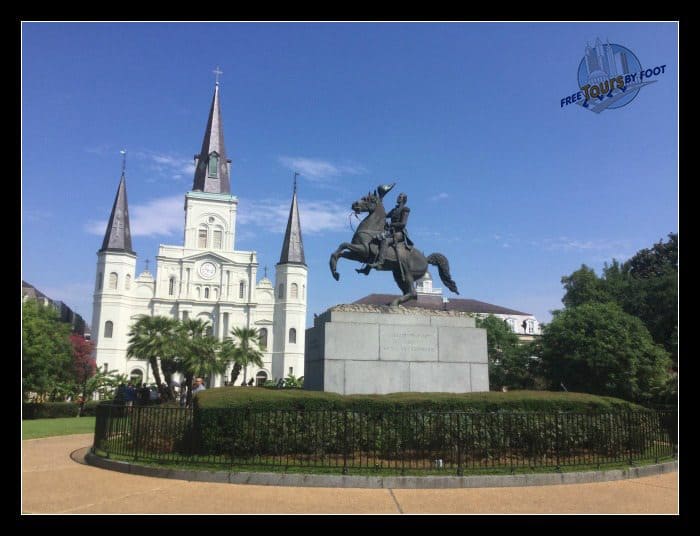
The United States had acquired New Orleans and the Louisiana Territory at great expense just twelve years before and it was a prime target for a British invasion.
The city was poorly defended, having only an inexperienced militia and a handful of combat-ready ships, and William C. C. Claiborne, the much-resented first American governor of Louisiana, was hard-pressed to bridge differences and muster a strong defense.
General Jackson was credited with unifying Creole, and American locals, militiamen from other parts of the United States, the nation’s first battalion of free people of color, local Native Americans, and even the Lafitte brothers, the famous and influential pirates, into an effective patchwork fighting force.
Besides this, tactical missteps on the part of the British, who were unfamiliar with the marshy terrain and the best ways to navigate it, assured a surprising and lopsided victory, with British casualties of around 2000 and American casualties under 100.
News later came that the peace treaty had already been signed, placing the Battle of New Orleans outside the boundaries of the war, but the battle nonetheless assured General Jackson’s reputation as a war hero and helped secure his later presidency.
The position of the horse – rearing up on two legs – does not indicate, as it is said to in other statues, that General Jackson died in battle.
Its sculptor, Clark Mills, was praised for keeping 20,000 pounds of bronze balanced on the two small hooves – the first time this was accomplished.
This is one of four copies; you can see the original on the White House grounds in Washington, DC.
The caption on the pedestal – “The Union must and shall be preserved” – paraphrases Jackson’s words spoken in 1830 in response to South Carolina threatening to secede from the Union.
It was added in 1861 when New Orleans was occupied during the American Civil War.
The large trees that shade the edges of the park are Southern Live Oaks and the square is surrounded by several historic buildings.
Just across Decatur Street from Jackson Square is the famous Cafe du Monde , where visitors flock daily for coffee and beignets.
While the cafe is open 24 hours a day, most visitors go during breakfast hours, so the wait can be long in the morning, but seating and service are usually quick in the afternoon and later.
TIP: Why don't you join us on our daily, pay-what-you-like French Quarter Food Tour or check out our top 13 foods you must try in NOLA, many of which you can get in the Quarter?
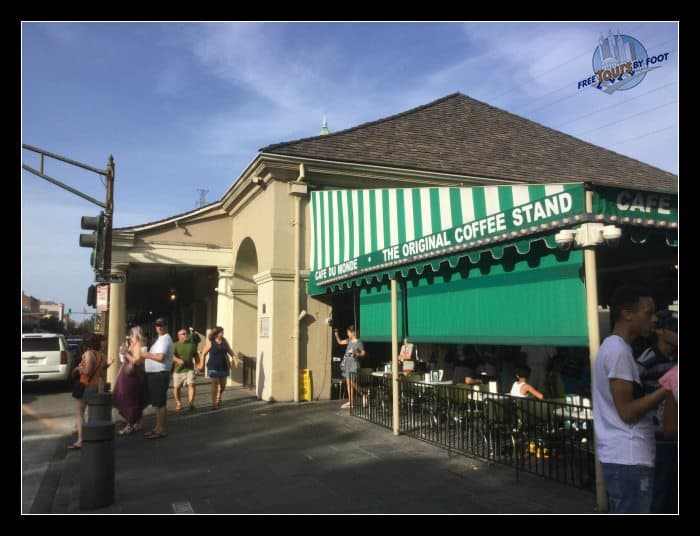
Coffee and beignets are not only the signature items – they’re the majority of the menu. Beignets are the only food they offer, and you'll find only a few other drinks besides coffee with chicory.
If you're a fan of espresso or if you're the kind of coffee drinker who likes choices, Spitfire Coffee on St. Peter Street just outside the Square is the place for you.
If you prefer a heartier breakfast than what's on offer at Cafe du Monde, Stanley is a good option to consider.
Named after the character in A Streetcar Named Desire, Stanley serves local riffs on classic breakfast items all day, along with a bistro-style lunch menu.
For dinner, the main attractions in the Square are two upscale Creole restaurants - Tableau and Muriel's .
Creole cuisine is the classic food of New Orleans, based on French cuisine but infused with the local blend of ingredients and cultures.
Both restaurants are rated between 4 and 4.5 stars on Google, Yelp, and Tripadvisor; both get praise for brunch and for special occasion dinners, and Tableau also gets shout-outs for its happy hour.
Beyond this elegant pair, you can find several more excellent restaurants within a block of the Square.
Just along St. Peter Street going toward Bourbon is the Gumbo Shop , an icon of casual Cajun/Creole cuisine, with more gumbo options on their menu than any other restaurant in the French Quarter and also one of the neighborhood's most affordable choices.
By the way, you might be interested in our choices for finding the best gumbo in New Orleans .
Gumbo Shop tends to have a line out the door during prime meal hours, but you've got La Divina Gelateria right across the street if you want to have dessert first while you wait in line.
Just up Chartres Street from the Square are Sylvain and Doris Metropolitan , both classy casual options with eclectic menus; Doris Metropolitan, which specializes in dry-aged beef, has the most positive reviews among all the restaurants listed here, consistently scoring 4.5+ on Google, Yelp, and Tripadvisor.
Because of their prime location, reservations are a good idea at any of these restaurants besides Gumbo Shop, especially for dinner.
Bars per se aren't much of a presence in Jackson Square, but Tableau, Sylvain, and Doris Metropolitan all have bar seating areas and the option of to-go drinks.
For something less fancy, there's Cafe Pontalba, right at the corner of Chartres and St. Peter.
Artists, performers, and fortune-tellers all play a huge part in Jackson Square's personality, and each group operates under slightly different rules.
Artists selling in Jackson Square or behind St. Louis Cathedral hold a license from the city that requires them to sell their own work and to sell only originals.
There has been what some call an open-air artist colony here for several decades, and it's a great place to get a unique souvenir .
These requirements aren't followed with perfect consistency, but it does mean that more often than not the artist who made the work is right there to speak to you about it and that anything you take home is unique.

Performers, by contrast, aren't currently regulated by the city except on a few essentials like volume.
The community of musicians, magicians, dancers, and acrobats who make their living in Jackson Square all work together to share the space, and typically this means you'll see a constant rotation of acts in the course of the day.
Mostly, you'll find bands in front of the Cabildo and the Presbytere , while non-musical acts mostly happen in front of the Cathedral.
Occasionally, there will be a large acrobatics show or a traveling choir or band in the amphitheater across Decatur Street from Jackson Square as well.
Because performers aren't regulated or compensated by the city, they make their living on what their audiences decide to leave for them.
Local regulation on fortune tellers of any kind does not allow them to charge for their services. The exception is readings that makeup part of a religion like voodoo.
So voodoo-affiliated establishments like Voodoo Authentica or the Historic Voodoo Museum can offer these services at a fee, while the tarot and palm readers in Jackson Square operate on a pay-what-you-will basis.
Things to See in Jackson Square
Start at the intersection of Chartres and St. Peter Streets, by the Cabildo.
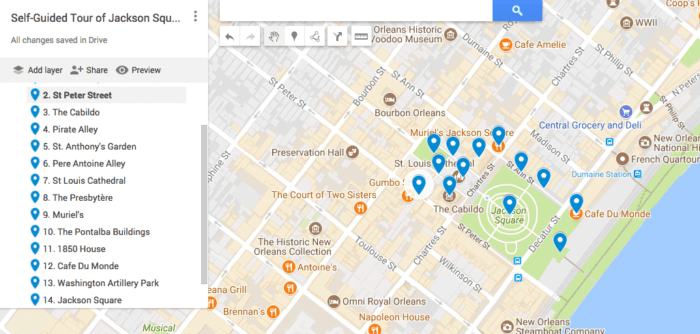
1. Jackson Square
From here, you can see much of the Square – both the stone-paved area outside the fence and the park inside it. At the corner of the park, you can see a cannon.
Jackson Square, when New Orleans was founded in 1718, was the Place d’Armes – the military parade grounds and a public square for the city.
We’ll see the inside of the park further along.
2. St. Peter Street
Now, look at the corner to see Tableau, a fairly new restaurant just across the street from the Cabildo.
Further along St. Peter Street, beyond Tableau, is Le Petit Theatre du Vieux Carre, or the Little Theater of the French Quarter.
This theater opened in 1917 inside Jackson Square, then soon relocated to its present site.
Le Petit represents the French Quarter’s most Bohemian era, when the neighborhood, after decades of architectural neglect following the Civil War, became a hub for artists and eventually for travelers and preservationists.
Until recently, Le Petit had two stages; after Hurricane Katrina, in order to finance necessary repairs to the building, they sold their smaller stage to the Brennan family of restaurateurs who renovated the space and launched Tableau.
Shortly beyond Le Petit, on the top floor of 632 St. Peter Street, is one of the several former residences of Tennessee Williams, where the playwright lived when he wrote A Streetcar Named Desire
3. The Cabildo
Opposite Tableau, inside the Square, is the Cabildo, a National Historic Landmark.
A cabildo is a Spanish city council; this building, standing on the site of city government from its founding until 1853, earned the name of the governing body that sat within it.
The signing of the Louisiana Purchase took place inside this historic building.
Today, it’s the home of the Louisiana State Museum’s most extensive collection of artifacts on the history of New Orleans.
4. Pirates Alley
From in front of the Cabildo, look just to the right of the building, at the corridor that retreats between the Cabildo and St. Louis Cathedral.
This is Pirates Alley .
Formerly, Cabildo Alley, the narrow pedestrian walk was renamed in 1964 to reflect local legends, which make the alley the site of an early 19th-century black market run by the Lafitte pirates.
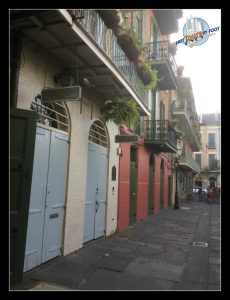
The Lafittes were two charming brothers whose booming piracy business brought both goods and people for sale to New Orleans.
While the Lafittes sold many of the necessities of life, they also prospered on the illegal sale of enslaved Africans.
Whether or not the alley was home to one of their markets, the Lafittes certainly kept company with a privileged clientele – such as those who would have worked in the Cabildo and Cathedral – and Jean Lafitte also certainly served a brief sentence in the prison once located along this alley, on the back of the Cabildo.
Today, there’s no question that pirates walk the alley, thanks to the pirate-themed bar located halfway along its length – the Pirates Alley Café, a destination for absinthe.
Just beyond the café is Faulkner House Books, located in one of the two locations where the novelist William Faulkner lived during his brief one-and-a-half-year stay in New Orleans, during which he wrote his first two novels.
Today, you can find an excellent selection of the works of southern writers, new and old, in the bookstore, plus a case of historic local books; the staff are well-read and can help you pick your best introduction to Southern Gothic.
5. St. Anthony’s Garden
Continue until the end of Pirates Alley, then turn right onto Royal Street. Halfway down Pirates Alley on the right, the Cathedral comes to an end, giving way to St. Anthony’s Garden.
While the park is not open to the public today, the fence along Pirates Alley, continuing around the corner onto Royal Street, is one of the two places where artists are permitted to display original works, brightening the alley with the intense color palette common in the local art.
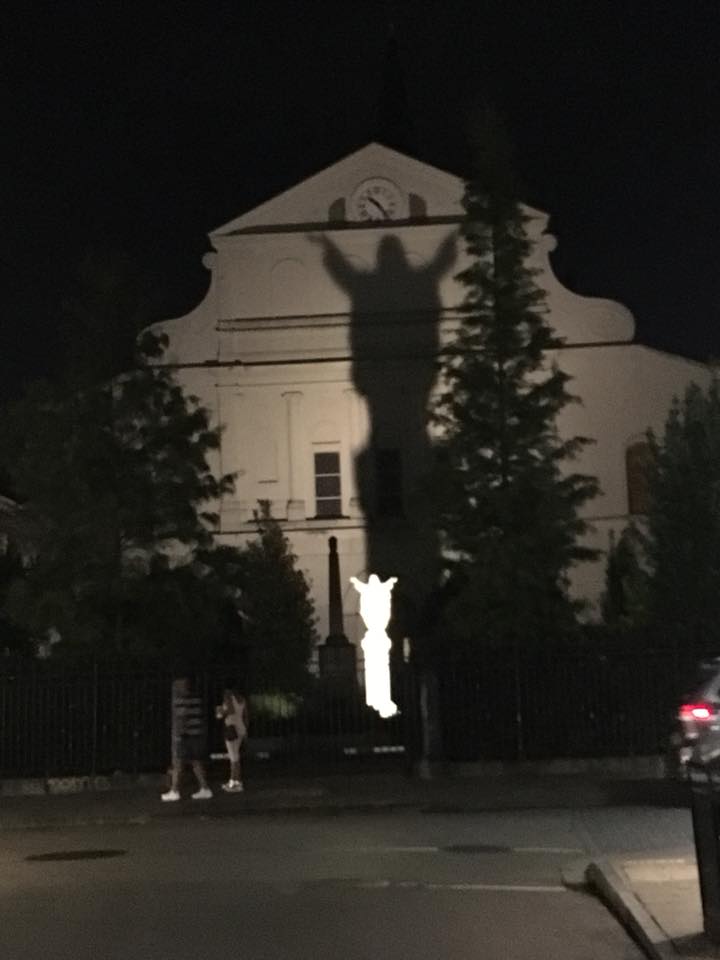
At night, visitors gather around the back fence of St. Anthony’s Garden to take pictures of the giant shadow cast by a low lamp that shines on the statue of Jesus – a striking figure referred by those familiar with it as “Touchdown Jesus.”
6. Pere Antoine Alley
On Royal Street, take a right into Pere Antoine Alley, the alley flanking St. Anthony’s Garden on the opposite side from Pirates Alley.
Except during the busiest times of the year, Pere Antoine Alley is far quieter than Pirates Alley, home to offices of the Archdiocese of New Orleans.
The namesake of the alley was a Spanish priest, Fray Antonio de Sedella, sent to New Orleans during the Spanish Inquisition, but viewed fondly by French-speaking parishioners and thus nicknamed Pere Antoine.
The alley sees more activity at night when ghost tours pass through telling a number of stories, including the claim that Pere Antoine can sometimes be seen helping to lead mass in the Cathedral today.
7. St. Louis Cathedral
Continue through Pere Antoine Alley back to Jackson Square and take a look at St. Louis Cathedral from the front.
As you see it today, the Cathedral dates to 1850. The oldest still-functioning Catholic cathedral in the United States, St. Louis Cathedral is a minor basilica.
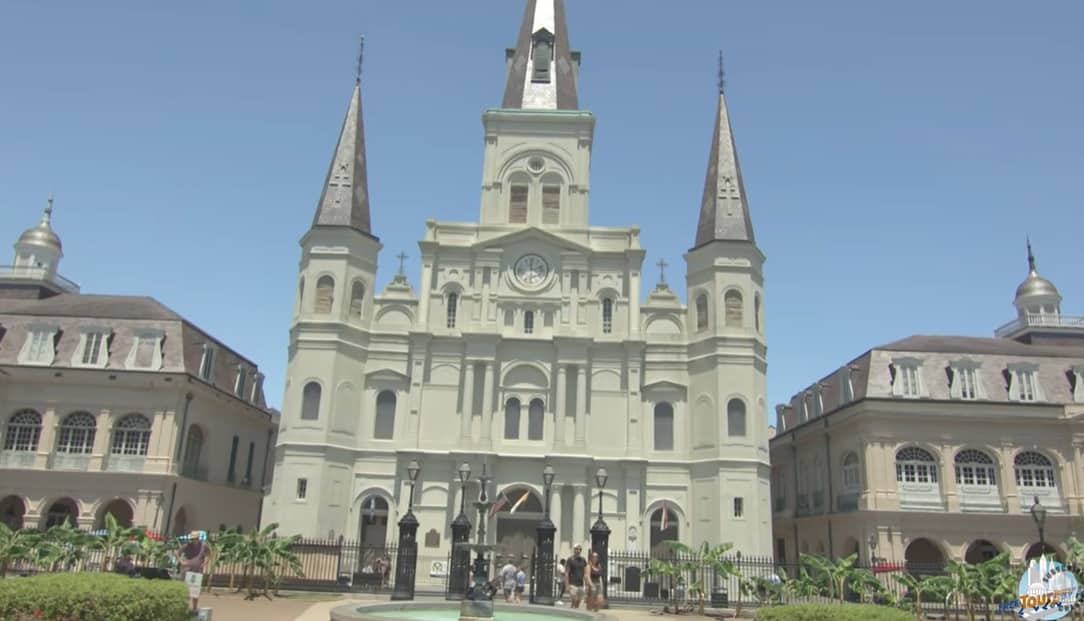
Above the central doors of the Cathedral, in the left stained glass window, you can see the shape of Don Andres Almonaster y Roxas – the man responsible for rebuilding the Cathedral, Cabildo, and Presbytere after the great fire of 1788.
Beginning from a candle on a home altar, the fire spread through 80% of the small, mostly wooden city, destroying about 800 buildings.
Don Almonaster paid for and organized the reconstruction of these three buildings, reviving much of the social and political core of the city. Later additions were made to transform these buildings into what we see today.
To get a sense of how things looked in Don Almonaster’s time, turn around and look for a plaque on the fence surrounding the park, just to the left of the gate nearest to the Cathedral.
(More information will be provided shortly about the changes that led to the current appearance of the Cathedral and its neighbors.)
The Cathedral itself is open to visitors from mid-morning to early evening, as long as there is no ceremony in progress; mass is also held at least once daily and is open for visitors to attend, provided you arrive before the ceremony begins (see the section on the Cathedral in the article above for details).
8. The Presbytere
From here, continue to the Presbytere – the Cathedral’s neighbor to the right, opposite and nearly identical to the Cabildo.
The French name presbytère implies a parsonage, and this building was constructed with a priest’s residence in mind; in practice, though, it housed a variety of church and state functions, including a courthouse.
Today, the Presbytere, like the Cabildo, is part of the state museum system, housing two long-standing exhibits.
The ground floor is focused on Hurricane Katrina, with artifacts, media, and interviews that help to drive home the impact, both immediate and ongoing, of this disaster.
The outdoor displays relate to this theme. Inside the ground-level gallery, on the left, you can see a sign paying tribute to the US Coast Guard, whose rescue efforts in 2005 saved 3689 lives along the Gulf Coast.
On the right is a small boat of the sort often owned by casual or professional fishermen in south Louisiana, many of which were used in immediate, less organized rescue efforts conducted by neighbors before troops were deployed, and who were also responsible for saving hundreds of lives.
The upstairs of the museum covers past and present traditions related to Carnival, the annual season of celebration that culminates in Mardi Gras .
9. Muriel’s
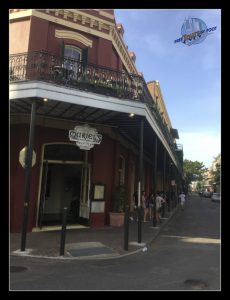
Beyond the Presbytere, across St. Ann Street, is Muriel’s, a Creole restaurant.
If you continue a short way along Chartres St. past the door to Muriel's, you'll soon see a gate on the left leading into an old carriage corridor.
At the end is a single table which the staff daily sets for two as an accommodation to the ghosts believed to occupy the building; this corridor, along with the séance lounge in the upstairs of the restaurant, make Muriel's a particularly popular stop on ghost tours.
10. The Pontalba Buildings and Baroness Pontalba
Turn back and reenter the Square; in front of the Presbytere, look to your left at the long building that runs the full length of the Square.
This is the Lower Pontalba, one of the two Pontalba Buildings - its twin on the opposite side of the Square is the Upper Pontalba.
They bear the name of their builder, Baroness Pontalba, the New Orleans-born daughter of Don Andres Almonaster y Roxas, the aforementioned builder of the Cabildo, Cathedral, and Presbytere.
Born in New Orleans as Micaela Almonaster during her father’s construction project, she married a cousin, moved to France, survived a murder attempt by her father-in-law, and became a baroness before returning home and expanding her father's buildings to the form you see today.
Her Mansard-style additions on the upper floors reflect the fashions of Paris in the 1840s and stand in contrast to her father's Greek Revival designs in the lower floors.
The condition of the Cathedral required that it be almost completely rebuilt – so only part of the front wall remains from her father’s era.
Her renovation also transformed the rest of the Square, as she redesigned the park, added the Pontalba Buildings to replace tenements, and commissioned the statue of Andrew Jackson you'll see later, giving Jackson Square its current name.
The cast iron railings on the Pontalba Buildings were the first ever seen in New Orleans, establishing a tradition that remains strong today; a look into the center of the ironwork design will reveal intertwined cursive letters A and P, which stand for Almonaster and Pontalba, her birth surname and her title.
11. 1850 House
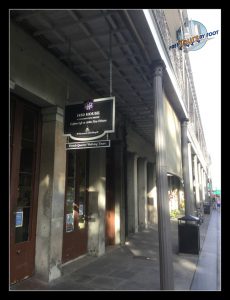
Walk along the Lower Pontalba Building until you reach 1850 House, about halfway along the length of the building.
The Pontalba Buildings were designed as townhouses, each with a ground-level business space to be operated by the occupant or rented, plus two floors of residence above it, an attic, a courtyard, and a three-story outbuilding behind.
Today, they have been split into single-story apartments; however, 1850 House maintains one of the original townhouses as it would have looked around 1850.
The Baroness herself lived in a middle unit on the opposite side of the park from 1850 House.
12. Café du Monde and the French Market
Continue in the same direction toward Decatur Street. Across the street, you'll see the green and white striped awning of Cafe du Monde .
The coffee with chicory served at Cafe du Monde and so many other local cafes is a relic of the American Civil War, when New Orleans was cut off from imports and used chicory, the root of the endive plant, to extend the limited supply of coffee.
Cafe du Monde has stood at this location since 1862 and has several other locations in Louisiana, but the majority of Cafe du Monde locations are in Japan.
Japanese investors opened fourteen locations after taking a shine to the French Quarter original during the 1984 World's Fair.
Cafe du Monde also represents the beginning of the French Market , which extends down Decatur Street to your left and continues nearly to the end of the French Quarter.
In the 18th and 19th centuries and early in the 20th, the French Market provided for all the daily needs of French Quarter residents.
But well before that, going back as much as 1000 years, the various Native American groups of the region used the site as a meeting point and trading post.
The site was ideal for transport, combining river frontage and high elevation with easy access to a natural land bridge leading out through the wetlands toward Lake Pontchartrain.
Contact with the Choctaw Native Americans shaped the early French colony of New Orleans, and the French Quarter's location is the clearest of these influences today.
From here, turn right along Decatur Street.
13.Washington Artillery Park
Across Decatur Street on your left is Washington Artillery Park.
Besides providing a great view of both Jackson Square and the Mississippi River, the park also commemorates the Washington Artillery, a long-standing organization that has been variously a militia, a benevolent society, and a division of the Louisiana National Guard and participated substantially in the American Civil War and in World War I.
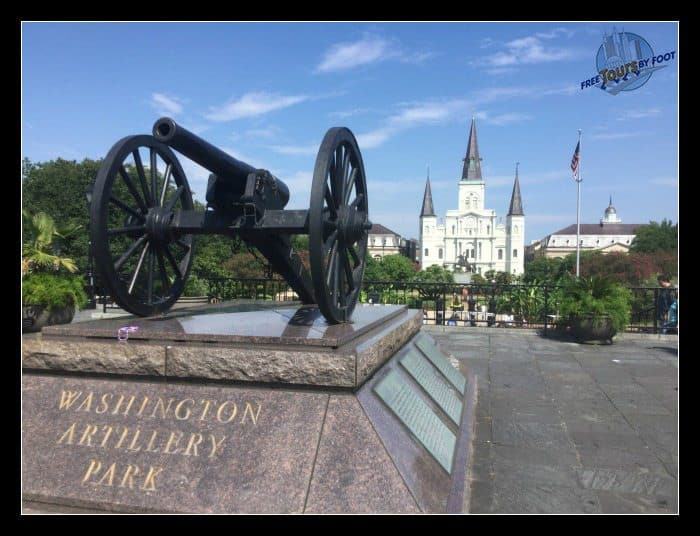
Beyond Washington Artillery Park is the Mississippi riverfront – one of the few portions open to pedestrians, as most of the riverfront in the city remains an active commercial port today.
The park bordering the French Quarter is called the Moonwalk after Mayor Moon Landrieu, under whom it was constructed.
Across the street from Washington Artillery Park, bordering the fence of Jackson Square is where you’ll most reliably find mule-drawn carriages offering tours of the French Quarter and surrounding neighborhoods.
15. The Shops at Jax Brewery
The Jackson Brewery was the ninth-largest single-plant brewery in the nation and the biggest independent brewery in the South.
The brewery was the only one in New Orleans to survive Prohibition and operated continuously for more than 80 years.
Instead of being a functioning brewery today, the structure now houses the finest shops in the French Quarter of New Orleans and offers some of the city's most spectacular vistas of the Mississippi River.
Weddings in Jackson Square
Both St. Louis Cathedral and the park in Jackson Square are popular sites for local and destination weddings, and there's always a chance you might run across a wedding (or a wedding photo shoot, or maybe a proposal!) while strolling through the Square, especially in the spring or fall.
Local weddings are hard to miss - they tend to end in a second line, a police-escorted, brass-band-led foot parade where the celebrants wave handkerchiefs and decorated umbrellas as they dance their way to the reception site.
While the Cathedral hosts religious ceremonies managed by the Archdiocese of New Orleans, Jackson Square is city property and sees weddings led by both ministers and city officials.
City policy keeps the park open to the public during wedding ceremonies, which limits the size of events held here.
To hold a wedding in the Square, you can find rates, guidelines, and contact information here: https://www.nola.gov/parks-and-parkways/event-rules-regulations/weddings-in-jackson-square/
SEASONAL EVENTS
In addition to all of the fun activities you can enjoy at any time of the year, Jackson Square also plays host to several notable events during holidays and celebrations.
Some of these activities are entirely free, but others will require a ticket for admission. We recommend arriving early for each activity in order to get a good spot.
Horse-Drawn Carriage Parade
This activity is part of the Spring Fiesta Festival . After the "Night in Old New Orleans" parade, the Spring Fiesta Queen and her court hold a presentation in Jackson Square.
If you want to take part in the celebration, head to the square when they hold this event in March. Check out our full post on things to do in March .
French Quarter Festival
This popular celebration of the French Quarter takes place in April, showcasing music from New Orleans and around the world.
Although there are a lot of different musical acts on display during this festival, one of the main music stages can be found at Jackson Square!
This is the largest free music event in the United States, and it's an excellent opportunity to hear some wonderful live performances.
Read our post on things to do in NOLA in April .
Satchmo Summerfest
What began in 2001 as a one-time celebration of Louis Armstrong has become a popular yearly music festival.
In addition to various seminars and exhibits, you'll also have the opportunity to hear a lot of wonderful Jazz music.
The Satchmo Summerfest is usually held during either the last weekend of July or the first weekend of August. Although this event is not free, tickets are only $5 per day.
Read guides for things to do in July and August .
Caroling in Jackson Square
Who doesn't love singing Christmas carols? If you're feeling the holiday spirit, you can join in with a large group of festive carolers in Jackson Square approximately one week before Christmas.
This event is entirely free, and you can learn more by visiting our post about things to do in December in New Orleans .
Dick Clark's New Years Rockin' Eve
Although the bulk of this show takes place in New York City, they have since expanded the show to New Orleans.
The main event takes place at Jackson Square, where Ryan Seacrest and other celebrities celebrate the new year by counting down to midnight.
Admission is free and you're welcome to take part in the festivities. Check out our post on things to do in December in New Orleans for more information.
The Cats of Jackson Square
Although this isn't specifically a seasonal activity, it's certainly fun and free to visit Jackson Square after dark and see all of the cats that gather here.
If you're looking for something fun to do during the Halloween season, you could try and find a black cat wandering around the square and spend some time with them.
For more information, check out our post about things to do at night in New Orleans .
Choose a Destination... I want them all PLUS general travel tips. Amsterdam Berlin Boston Charleston Chicago Dubai Lisbon London Los Angeles Miami Nashville New York City New Orleans Paris Philadelphia Prague Rome San Francisco Washington DC
About The Author
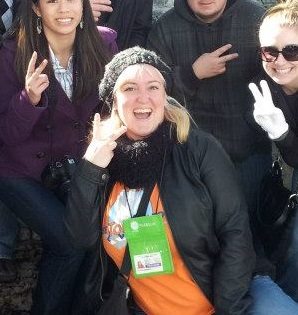
Sarah Hester
North america, united kingdom & ireland, middle east & india, asia & oceania.
Take a Tour of Jackson Square and Surrounds in the French Quarter in New Orleans
TripSavvy / Robyn Correll
The French Quarter is the oldest part of the city, and after almost 300 years it is still a vibrant area. Start your tour of the Jackson Square, named for General Andrew Jackson hero of the Battle of New Orleans , and its surrounds at Artillery Park, located on Decatur Street in front of Jackson Square. From here you can see the Mississippi River behind you and Jackson Square in front of you.
The Mississippi was the main artery for trade between Europe and the New World. Jean Baptiste LeMoyne, Sieur de Bienville, was ordered to move the capital of the French Louisiana colony from Fort Biloxi to a location on the River. However, the mouth of the river was dangerous for navigation. The Native Americans living in this area showed Bienville a “secret” way to get from Fort Biloxi, through two area lakes that took them to Bayou St. John. From there, they could easily navigate to this point on the Mississippi. The City was founded in 1718. The Streets of the French Quarter were laid out in 1721. Many of the streets running from the river are named for Catholic saints and many of the cross streets are named for the Royal house of France at that time. So Bourbon Street is not named for an adult beverage, but for the Royal House of Bourbon.
Two great fires nearly destroyed New Orleans in the 1700s. The first great fire of New Orleans started in the house at Toulouse and Chartres (619 Chartres) when on a windy Good Friday, March 21, 1788, Don Vincente Nunez lit a candle at a religious altar in celebration Good Friday that caught fire. Because it was Good Friday, the bells of the St. Louis Cathedral, normally used to alert the population of a fire, were padded to be silent. 850 homes were destroyed in this fire within 5 hours. The second fire was on December 4, 1794, destroying another 212 homes. After this, the Spanish implemented building codes that included thick brick walls, courtyards, and arcades. Examples of such buildings are the Cabildo and the Presbytere, rebuilt after the 1794 fire.
The river itself, the fourth longest in the world, drains 40% of all of America and is over a half-mile wide. Notice that you are actually standing on a levee. These levees were originally about a foot high and formed naturally; Bienville ordered they be raised to three feet. After that, the French riverfront landowners were to build and maintain levees at peril of losing their land. Crevasses, or breaks in the levees, occurred during floods and caused casualties to life and property. After the Americans bought Louisiana, the levee system was turned over to the Army Corps of Engineers. Witness Hurricane Katrina--the rest is history.
When you look out at the Mississippi River , notice how it curves into a crescent to your left. This gives New Orleans one of its nicknames, The Crescent City. The Mississippi continues to be the lifeblood of the City. The Port of New Orleans handles about 500 million tons of cargo each year, and is the largest port for rubber and coffee; in addition, more than 700,000 cruise passengers sail through the port each year.
Jackson Square
Affordable Art
Walk across Decatur Street and go into Jackson Square, an area that has always been a public square since the founding of the city in 1718. It was originally named the Place d'Arms. It was renamed when the statue of Andrew Jackson, hero of the Battle of New Orleans in the War of 1812 was placed there during a renovation in the 1850's. The inscription on the statue was added by General Benjamin Butler, the Union General who was over New Orleans during the Civil War to spite the citizens of New Orleans. During that period, the women of New Orleans crossed the street to avoid passing a Union soldier as a protest of Union occupation. Gen. Butler was not amused. He announced that he would prosecute any woman who did so as a prostitute. After that the women of New Orleans passed by Union soldiers on the street, but began putting pictures of Gen. Butler in the bottom of their chamber pots.
St. Louis Basilica, or St. Louis Cathedral, is the building centered behind the square. To its left is the Cabildo, formerly the seat of Spanish rule and now a part of the Louisiana State Museum. It was damaged by a fire in 1988 and authentically restored. On the other side of the Basilica is the Presbytere, former residence of the Capuchin monks, and later a courthouse. Today, it is also part of the state museum system. The Pontalba apartments are the oldest apartment buildings in the United States, having been built between the 1840-50’s. Today, the upper floors remain residential while the lower floors are commercial.
Jackson Square is the heart of New Orleans in modern times, visited daily by locals and tourists, surrounded by artists, street performers, and fortune tellers. It is also a main part of the French Quarter Festival held every April.
St. Louis Cathedral
The St. Louis Cathedral, just outside the Chartres Street gate was originally completed in 1729. It was destroyed twice by fires in 1788 and 1794. The existing cathedral was built after the last fire in 1794. This cathedral became St. Louis Basilica when Pope John Paul II visited in 1984.
Notice the two alleyways on the sides of the cathedral. The one on the left, between St. Louis Basilica and the Cabildo, is Pirate's Alley. It is thought to have been named after Jean Lafitte, the buccaneer who fought with Andrew Jackson at the Battle of New Orleans. Also an adventurer, Lafitte was a smuggler who was popular with the locals. After a price was put on his head by the governor, Lafitte in turn put a price on the governor's head. Formerly officially Orleans Alley South, the alley was officially renamed in 1964. It is still paved with the original stones that had served as ballast on ships that cruised the Mississippi, and its central drainage is European in design. Pirate's Alley does not always appear on city maps, but it is an important area in the French Quarter. Faulkner House, where "A Soldier's Pay" was written, is in the middle of the alley.
If you walk down this alley, notice the drainage in the middle. This is the Europeon method of water drainage. Since New Orleans is in the Mississippi River Delta, we have no natural stone. The stones used to pave these streets and alleys in the 1700s was ballast thrown on the banks of the river by ships coming in to port and no longe in need of them. The citizens of New Orleans collected thses discarded stones for use in paving. Soon, the captians of the ships became aware of the use and began selling the stones.
The Alleys On Either Side of the Cathedral
The alley, between St. Louis Basilica and the Cabildo, is called Pirate's Alley, and is thought to have been named after Jean Lafitte, the buccaneer who fought with Andrew Jackson at the Battle of New Orleans in 1816. Also an adventurer, Lafitte was a smuggler who was popular with the locals. After a price was put on his head by the governor, Lafitte in turn put a price on the governor’s head. Formerly officially Orleans Alley South, the alley was officially renamed in 1964. It is still paved with the original stones that had served as ballast on ships that cruised the Mississippi, and its central drainage is European in design. Pirate’s Alley does not always appear on city maps, but it is an important area in the French Quarter. Faulkner House, where “A Soldier’s Pay” was written, is in the middle of the alley.
The alley between the St. Louis Cathedral and the Presbetyre is Pere Antoine's Alley, named for Friar Antonio de Sedella came to New Orleans around 1774. There are some who say, Pere Antoine still haunts the area.
The Cabildo
The building to the left of the St. Louis Cathedral (as you are facing it) is the Cabildo, built in 1794. The Cabildo is the site where the Louisiana Purchase was signed. It also served as the seat of government during Spanish rule. It is currently used as a Museum that has the death mask of Napoleon in one of its exhibits.
The Presbytere
If you're facing the Cathedral, look to it's right. There you will see the Presbytere, former residence of the Capuchin monks, and later a courthouse. Today, it is also part of the state museum system.
The Pontalba Apartments
On either side of the square are the Pontalba Apartments built by the Baroness Michaela Pontalba in the 1850's. They are the oldest apartment buildings in the United States. The Baroness is a colorful figure in New Orleans history. She is the daughter of Don Andres de Almonaster y Roxas, who is buried under the floor of the St. Louis Cathedral. Michaela survived an attempted murder by her father-in-law in Paris 1834. She returned to New Orleans 1848 to find the old Creole families were moving to Esplanade Avenue. Seeking to restore this area of the French Quarter, she built her grand row houses, and convinced city officials to renovate the Square, and surrounding buildings to resemble the great public squares in Europe. During construction, Michaela would supervise, often climbing up and down scaffolding checking everything. She constructed the buildings in 2 1/2 years at a cost of $302,000.
Le Petite Theatre
Walk out onto Chartres Street, past the Cabildo. At the corner of Chartres and St. Peter Street, you will see the Le Petite Theatre du Vieux Carre. Theatrical productions have been given here regularly since 1922, and continue today. It is reputed to be haunted by an elegant man in evening dress.
Walk up Chartres Street 1/2 block and look for a pink building with a historic plaque. It is here on March 2, 1788, that Sr. Vincente Nunez was lit the candle that started the fire that destroyed much of the city.
The Cafe Du Monde
TripSavvy / Violet Smirnov
Maybe now you're ready for some relaxation, a cup of coffee and chicory, or cafe au lait and some beignets(say, "ben yeahs"). Then walk over to the Cafe du Monde next to Artillery Square and enjoy. The Cafe du Monde has been serving coffee since 1865 and is part of the original French Market. It's open 24/7 except for Christmas Day and the occasional hurricane.
10 Neighborhoods You Need to Know in New Orleans
A Complete Guide to the Mississippi River Road Trip
Your Trip to New Orleans: The Complete Guide
The Top 10 Museums in New Orleans
Take a Self-Guided Tour Along the New Orleans Riverfront
3 Totally Unique Public Yoga Classes in New Orleans
10 Top Romantic Things to Do in the French Quarter
A Day in the French Quarter
December in New Orleans: Weather, What to Pack, and What to See
French Quarter Bed and Breakfasts in New Orleans
10 Free Things to Do in New Orleans
The 11 Best Day Trips from New Orleans
The Most Photogenic Places in New Orleans
How to Visit New Orleans on a Budget
How to Spend Two Days in New Orleans
The 7 Best Beignets in New Orleans
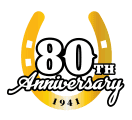
Discover New Orleans The Authentic Way

Breathtaking views. Authentic New Orleans culture. We've specialized in it for 80 years (and counting.)

Carriage rides in the French Quarter now operate 7 days a week pending weather. We have limited availability, please make sure to book your ticket now by clicking "book now". Guests will board the carriages at 700 Decatur St. in front of Jackson Square. We look forward to seeing you in our 82nd year in business!
Our Sightseeing Tours of New Orleans
New orleans history & haunts carriage tour, history and haunts carriage tour.
New Orleans is a city with a dark and sometimes sinister history. With Royal Carriages History & Haunts Carriage Tour, you'll discover a few of the reported hauntings, as well as the legends behind them!
1 hour tour - $60 per person (13 & up) $40 per person kids (5-12) Children 4 and under free (1 per paid adult)
Private Carriage Tour
Let our expert guides tailor a tour just for you! This unique one hour carriage experience travels through the French Quarter and beyond. These more intimate carriages seat 1-4 people per party.
1/2 Hour Tour is $150 1 Hour Tour is $300
French Quarter and More Tour
This fully narrated, hour long tour travels the centuries old French Quarter and the Faubourg Marigny; both neighborhoods as rich in history as they are in character. See architecture up close, and hear stories of famous New Orleanians.
Mules in the Marigny Walking Tour
Stable and neighborhood walking tour.
Explore the home of our Mules and stroll through one of the oldest neighborhoods in New Orleans.
2 hour tour - $35 per person (13 & up) $25 per person kids (5-12) Children 4 and under free (1 per paid adult)
Latest Royal News
Royal carriages introduces mules and the marigny walking tour.
May 11, 2024 - Royal Carriages is proud to offer an exclusive behind the scenes look at the oldest stable and carriage company in New Orleans. Guests will have an unique opportunity to meet our mules up close.... read more
This tour exceeded our expectations! We went on the Haunted Tour and our guide (Nate) was awesome!!!
TripAdvisor Member: Andrea S of Houston, Texas, USA
More reviews
Surprise Engagement Proposals
Chad & dani.
Royal Carriages provides romantic private carriage rides that are perfect for surprise engagement proposals. Let us arrange something amazing for you! #SheSaidYes #LoveByCarriage
more weddings & proposals
We are now open for walking tours only with full COVID-19 safety precautions in place. Please stay tuned for our launch of carriage tours as we phase back in. In the meantime, we invite you to book as we expand our product.

- Complimentary Planning Assistance
- Destination Wedding Guide Digital Copy
- Elopement Packages
- Marriage License & Legal Essentials
- Welcome Bag Ideas
- Second Lines
- The History of Wedding Umbrellas and More in New Orleans
- Wedding Cake Pulls
- Destination Wedding Guide Printed Copy
- Wedding Inspiration
- Wedding and Event Planners
- Photographers & Videographers
- Transportation
- Beauty, Hair & Makeup
- Spas, Health & Wellness
- Cakes & Bakeries
- Entertainment
- Engagement Photos in New Orleans
- Bridal Shower & Brunch
- Joint Bachelor/ Bachelorette Parties
- Bachelor Parties
- The Ultimate New Orleans Bachelorette Party Guide
- Honeymooning
- LGBTQ Bachelor / Bachelorette Party Itinerary
- Walkable Downtown
- Corporate Group Incentive
- LGBTQ New Orleans
- Convention Center
- Caesars Superdome
- Smoothie King Center
- Special Events Venues
- Hotels with Meeting Space
- Venue Search
- Custom Maps
- Services Directory
- Convention Services Request
- Exhibitor Services Request
- Custom Post Cards & Save the Date
- New Orleans Print Materials Request
- Visitor Guide Request
- Corporate Social Responsibility & Donations
- Emergency Planning
- Meeting Planner Guide
- Transportation Directory
- Transportation & Getting Around
- Promotional Videos & Images
- Stats and facts
- Free Things To Do
- Talk like a New Orleanian
- Local Outreach
- Social Media Resources
- Marketing e-Templates & Ads
- Convention Calendar
- Testimonials
- Submit Your Request for Proposal (RFP)
- Availability Grid
- Coupons Deals
- Group Transportation
- Assistance Request
- Bulk Brochure Request
- Photos & Videos
- Microsite Request
- Itineraries
- Performance Venues
- Motorcoach/Group Transportation
- Educational Opportunities
- Student Itineraries
- voluntourism
- Class Reunions
- Venue & Services
- Hotel Assistance
- Promote Your Reunion
- Family Reunions
- Military Reunions
- Regulations and Maps
- Motorcoach Parking
- Tax Free Shopping
- International Travel Tips
- Consulates in New Orleans
- Maps & Transportation
- Advisor VIP Pass
- Brochure Request
- Photos/Videos
- Cruise Coupons
- Pre-Post Packages
- General Coupons
- Voluntourism
- Group Travel Planner Guide
- Travel Advisor Certification
- International Groups
- Group Travel
- Cruise Lines
- Meet the Team
- Did You Know | New Orleans Facts
- Member Benefits
- Maximize Your Membership
- Application NOT USED
- Membership Policies
- Member Directory
- Member Events
- Member Anniversaries
- New Members
- Member Login
- Media Assistance Request
- What's New in New Orleans
- New Orleans Awards & Accolades
- Image Library
- B-roll Assets
- New Orleans & Company Press Releases
- Hospitality Industry Press Releases
- Image / Video Request
- Communications & PR Contacts
- New Orleans Festivals And Events
- French Quarter
- A Guide to New Orleans Nightlife
- Attractions
- Cultural Arts
- Mystical/Haunted New Orleans
- Family-Friendly Guide to New Orleans
- Multicultural
- Recreation & Outdoors
- Architecture
- Find Restaurants
- Where to Eat
- Traditional Foods
- Top Chefs In New Orleans
- Restaurant Deals
- Love To Eat Video Series
- Find a Place to Drink
- Where to Drink
- Classic New Orleans Cocktails
- Book a New Orleans Hotel
- Hotel Directory
- Bed And Breakfasts: Hotels - New Orleans & Company
- Saint Charles Avenue Hotels
- Luxury Hotels
- Garden District Hotels
- French Quarter Hotels and Lodging
- Downtown/Central Business District Hotels and Lodging
- Bourbon Street Hotels
- Green Hotels
- Bourbon Street Balcony Hotels - New Orleans & Company
- Haunted Hotels in New Orleans
- Pet-Friendly Hotels
- Historic Hotels
- Upcoming Events
- Ultimate New Orleans Event Calendar
- New Orleans LIVE Music Calendar
- Submit an Event
- Major Events and Festivals in New Orleans
- New Orleans Neighborhood Guide
- Streets to Visit
- Request a Guide
- Deals & Coupons
- Essential New Orleans Three-Day Itinerary
- Bleisure Itinerary
- Monthly Newsletter
- Insider's Blog
- Virtual Tour
- Accessibility
- New Orleans Artist Database
- LOVENOLA.TV 24/7 Broadcast
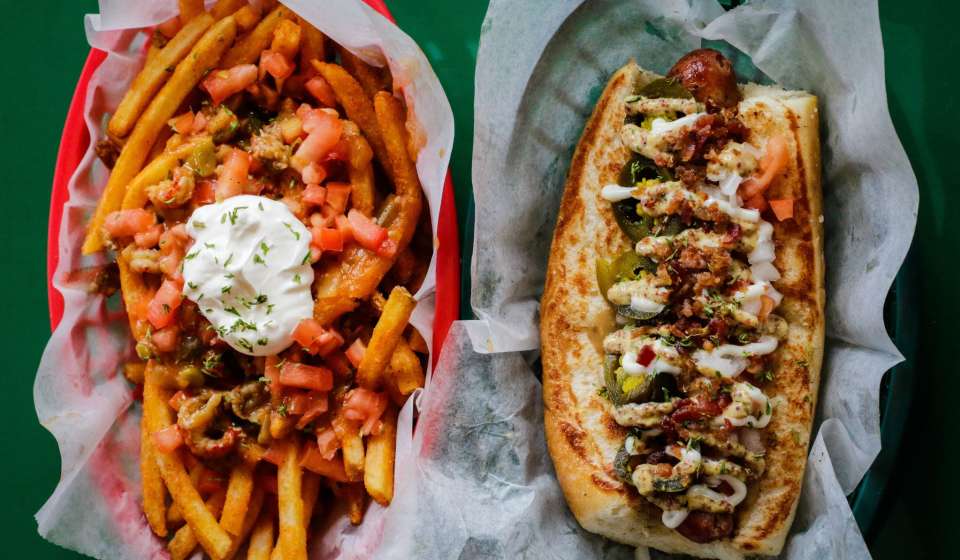
Jackson Square
- 751 Decatur St., New Orleans, LA 70181 ( Directions )
- 751 Decatur St. New Orleans, LA 70181 ( Directions )
- Neighborhood: French Quarter
- Park/Square
Attractions/Activities
- Admission: FREE
What is Jackson Square?
Known as one of New Orleans’ most recognizable landmarks, Jackson Square is a National Historic Landmark nestled in the center of the French Quarter. The 2.5-acre space welcomes over 2 million visitors and locals each year and hosts a number of city events and celebrations, weddings and photography sessions. Jackson Square has even served as a backdrop in a number of popular feature films and television shows. The landmark earns its name for the bronze statue of Andrew Jackson located in the center of the square.
Where is Jackson Square located?
Located on Decatur Street, between the Jax Brewery Shopping Mall and the French Market, in front of the St. Louis Cathedral you’ll find Jackson Square.
The area surrounding Jackson Square contains a mix of commercial and residential property. The Cabildo, The Presbytere (on the opposite side of the Cathedral), and one of the apartment townhouses of the Lower Pontalba Apartments are now state museums. The lower floors of the apartment buildings are shops and restaurants, while the second, third and fourth floors are residential apartments.
What is there to do at Jackson Square?
Jackson Square is also the location of an open-air artist colony, where artists display their work on the outside of the iron fence. Visitors even have the opportunity to see the artists at work and perhaps have their portrait drawn by one of the many talents utilizing Jackson Square as their studio.
Grab coffee and beignets from Cafe du Monde and enjoy breakfast while people watching in the Square.
If you are in the vicinity of the Convention Center, ride Riverfront Streetcar to the Jackson Square stop. If you are located in other parts of the city, just head for the French Quarter.
Xplorit Virtual Tour
Discover Jackson Square with one of the most comprehensive, completely immersive and interactive virtual experiences in the world.

- Visitor Gallery
- Main Gallery

- Convention Center:
- SuperDome/Arena:
- French Quarter:
- Things to Do
- Trip Planning Tools
- Meeting Planners
- Travel Professionals
- Press and Media
- Privacy Policy
- Site Search
- Doing Business in New Orleans
- About NewOrleans.com
- Report Fraud
- Accessibility Options

Sign up for special tips, offers, and info about all the latest happenings around NOLA with our monthly Insider’s Guide, delivered right to your inbox.

- Free Cemetery Tour
- Free Garden District Walking Tour
- Free French Quarter Tour
- Free Self-Guided Walking Tours of New Orleans with maps
- New Orleans Self-Guided Audio Tours
- New Orleans Jazz Music Tours
- Private Tours of New Orleans
- Free New Orleans Travel Guide
- Frequently Asked Questions
- Guest Posts
- Free Walking tours Worldwide
- Book A FREE Tour
Free Self-Guided Walking tour of The French Quarter with Map

Cost : Free Starting Point: 800 Decatur, Cafe Du Monde Ending Point: 941 Bourbon Street, Laffite’s Blacksmith Bar Total Distance: A fourth of a mile Time Required: About an hour or two Best Time To Go: Early morning is the best time to avoid crowds and heat Getting Here: The French Quarter is easily accessible by rideshare or public transportation. Parking is difficult, expect to pay. Our Tour starts in the heart of The Quarter right by Cafe Du Monde.
We offer a Free To Join Daily Walking tour of the French Quarter at 10am, find out more about our French Quarter Walking Tour . We also now offer an affordably priced audio tour version of The French Quarter tour
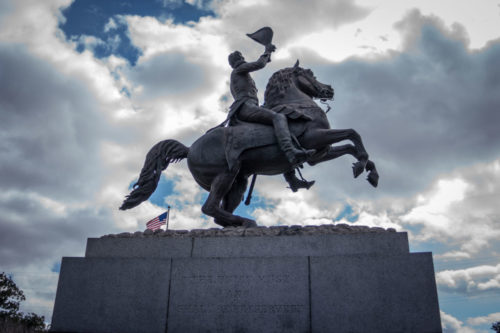
We’re excited to have you on this free self-guided walking tour of The French Quarter!
When you hear ‘Bourbon Street,’ partying, booze, and tourist traps may come to mind, but it is more than that. The French Quarter is a unique, magical place, that is also a mostly intact historic neighborhood that has been around for over 300 years!
Let us show you precisely what makes us fall in love with The French Quarter over and over, every day of our lives, fueling us to do what we do!
Once you’ve fallen in love too, join us for our free “pay what you feel” daily tour that starts at 10 AM daily and leaves from 768 Decatur, right next to Cafe Du Monde.
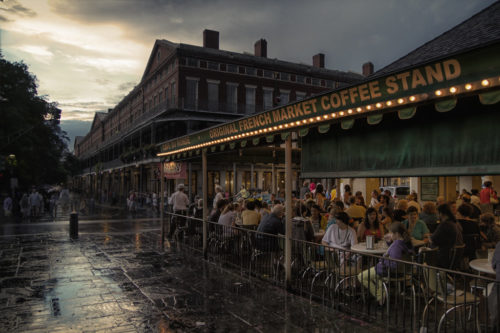
Start your French Quarter tour at the world famous Cafe Du Monde.
Synonymous with New Orleans, the original Cafe Du Monde was established in 1862. There is almost always a line, but don’t get discouraged because it moves quickly, and we promise it’s worth it!
Cafe Du Monde serves dark roasted Coffee with Chicory, Beignets, White and Chocolate Milk, and fresh-squeezed OJ. The coffee here is served Black or Au Lait (mixed half and half with hot milk), and the world-famous beignets covered with powdered sugar.
Our Free French Quarter Tour meets next door, and we often judge how busy The Quarter is by how long Cafe Du Monde’s line is! Pro Tip: Want to skip the crowds? You’re in luck- Cafe Du Monde is open 24/7, so come back after dinner or before a late-night on Bourbon street.
You can grab a table at Cafe Du Monde or get your coffee and Beignets to go. Walk up the ramp to the first stop on the tour, which features benches, if you’d like to sit and enjoy your beignets and enjoy the view.

You can sip on your Cafe Au Lait Cafe while watching street performers and taking in the fantastic view! Located across the street from Decatur Street from Jackson Square, the Washington Artillery Park and Terrace has spectacular views of the Square, with Saint Louis Cathedral in the background. Behind you, along the Mississippi, is the riverwalk (officially named Moonwalk Park), one of the best places to walk or jog around New Orleans .
Pro Tip: Watch out for locals asking where you got your shoes (Answer: they’re on your feet!)
From here you should have a great view of our next stop, The Mississippi River!

New Orleanians sitting on the Moonwalk next to the Mississippi River
The Mississippi is the second-longest river in North America, starting at Lake Itasca in Minnesota and disappearing into the Gulf of Mexico in Southern Louisiana. The Mississippi reaches almost 200 deep in The French Quarter, the deepest part of the entire river! It is the reason the city was built.
Indigenous people have made a home along the Mississippi River for thousands of years, using it as a highway and source of fish. The Europeans came during the 16th century, and the river was a barrier, forming borders for New France, New Spain, and the United States. In the 19th and 20th centuries, steamboats took over the space to transport agricultural and industrial goods.
Learn more about New Orleans’ early history in our video .
A short, 15-minute walk from here, you’ll find the Outlet Mall at Riverwalk, near Canal Street, and a nearby artists co-op (912 N Peters).
Looking towards the Mississippi river you can see our next stop
Named after former New Orleans mayor Maurice Landrieu (Moon) for his significant role in creating the riverside boulevard, Moon Walk is a mile-long paved promenade along the Mississippi River.
Moon Walk is a popular place for locals and tourists alike, filled with artists, musicians, and street performers, plus some of the best views of New Orleans and the Mississippi. Relax on the benches that line the river and watch steamboats, cruise ships, and container ships roll past. The Moon walk is a great place to stroll, find out about the best places to walk, hike and jog in New Orleans
How to access the Moon Walk
Use St. Philip, Dumaine, St. Peter, Toulouse, St. Louis, Conti, and Bienville Streets or Washington Artillery Park to get to the Moon Walk.
Monuments along the Moon Walk
“Monument to the Immigrants,” a statue by Franco Allesandrini “Old Man River” by Robert Schoen The Holocaust Memorial by Israeli sculptor Jacob Agam
Walk down the stairs or ramp to cross the street to the next stop
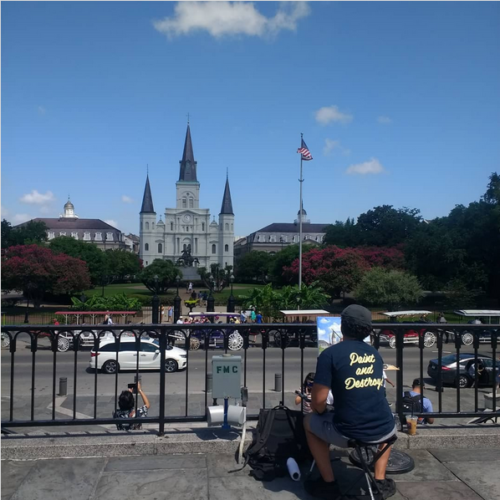
Since the beginning New Orleans has had one central square or gathering/meeting place. Originally Place d’ Armes, a muddy square where the French military paraded and public executions occurred. Today that dirt patch is the world-famous Jackson Square. In 1850, Baroness Micaela Almonester Pontalba redesigned the square in the style and spirit of the parks and gardens of Paris and renamed it in honor of Andrew Jackson. She redesigned the Square around the statue of Andrew Jackson, with circular paths surrounding the General in the center. And what was once a muddy field became Jackson Square, named after General Andrew Jackson, who led the city to victory in The Battle of New Orleans.
Today’s Jackson Square
Today, Jackson Square is still a vibrant place and the center of the French Quarter. The fence around the Square is filled with artists selling their crafts and fortune-tellers waiting to show you the future at any time of the day or night. Jackson Square has appeared in The Curious Case of Benjamin Button, K-Ville, and The Originals.
What is the Vieux Carré?
Vieux Carre (Pronounced “VOO car A”) is the original name of The French Quarter. French for “old square,” a reference to Jackson Square. The Vieux Carre only came to be known as The French Quarter after the Louisiana Purchase encouraged Americans to move to the city, who noted its distinctly French creole flair and started called this part of town “The French Quarter”.
Pro Tip: All the art is original and makes for impressive and authentic souvenirs. Artists who sell their crafts in Jackson Square are licensed by the City of New Orleans. Most artists will ship if you don’t want to risk damaging your new masterpiece on the return flight home.
From Jackson Square you can see the next five stops.
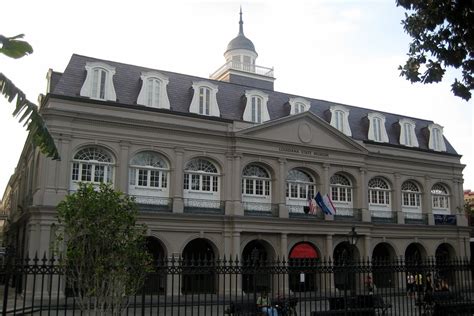
With Dectuar street at your back ahead of you will see our next stop The Presbytere which is the building to the right of the cathedral. Constructed in 1813 to match the Cabildo, The Presbytere was initially called Casa Curial (“Ecclesiastical House”) and intended to house clergy; however, it was never used as a religious residence. Eventually, The Presbytere would be absorbed as part of the Louisiana State Museum and declared a National Historic Landmark. Today, you’ll find exhibits that tell two sides of the Louisiana story: one of celebration (Mardi Gras: Its Carnival Time in Louisiana) and one of resilience (Living with Hurricanes: Katrina and Beyond).

You’ll notice the prestigious Cabildo right away. It is to the right of The Presbytère and is nearly identical. This elegant Spanish Colonial building is home to rare and cherished pieces of New Orleans history and is itself a piece of history. Built around 1795, The Cabildo has been the site of several pivotal US moments, such as the Louisiana Purchase, which finalized the US acquisition of Louisiana, and the definitive landmark Plessy v. Ferguson Case, which was a challenge to the segregation in the late 19th century.
Today, the Cabildo Museum proudly showcases the history of The French Quarter, New Orleans, and Louisiana, emphasizing diversity of the people of New Orleans.
The next stop are the two identical buildings on the left and right of Jackson Square.
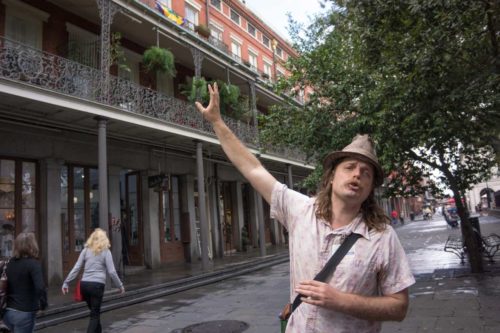
The red brick, four-story-tall Pontalba Buildings divide the two sides of Jackson Square, watching over the artists and their patrons.
Designed and constructed by businesswoman Baroness Micaela Almonester Pontalba, the two Parisian-style houses have custom-made cast-iron railings featuring her monogram. Other cast-iron galleries in the Quarter were shipped into town from the east coast.
These galleries were typical everywhere in the US by the 19th century but now are uncommon. They are now refereed to as ‘lace balconies’ in New Orleans as they resemble lace.
On the Pontalbas bottom floor, you’ll find restaurants and shops, and on the upper floors, you’ll find apartments, the oldest (continuously) rented apartments in the US, to be exact.
Before you move on to the next stop look closely at the cast iron, do you see the Baroness’s monogram? You should see both a A and a P.
Part of the Lower Pontalba Building, the 1850 House offers a rare glimpse into New Orleans’ posh Antebellum period. Owned by the Louisiana State Museum, the 1850 House is furnished to represent life in mid-nineteenth-century New Orleans.
As former apartments, the residents of this house changed every few years, and the current 1850 House displays do not represent any individual family but rather the antebellum period in general.
The museum is a summary of one of New Orleans’ most prosperous periods and is designed to show the daily life of the upper-middle class during that time.
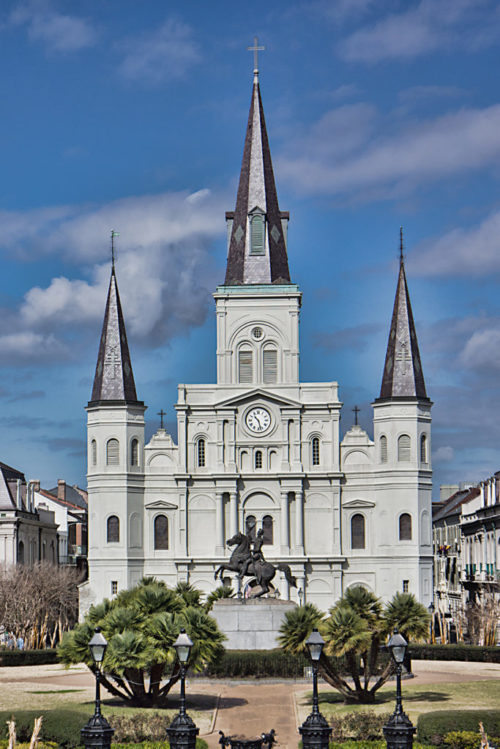
You have probably already noticed one of New Orleans’ most notable landmarks. The mystical Saint Louis Cathedral, whose presence watches over Jackson Square, visible at nearly every corner. Built in 1794 St Louis Cathedral is the oldest cathedral in the United States.
With three steeples proudly towering above its historic neighbors (The Cabildo and The Presbytere), the Saint Louis Cathedral is the oldest cathedral in the United States. Notice the bell embossed at the center with the name “Victorie” in commemoration of The Battle of New Orleans victory in 1815.
Rumors of Hauntings
The Saint John Cathedral is said to be haunted by Dr. Antonio de Sedella (Pere Antoine), who was a priest whose body is buried within the cathedral. During Christmas Midnight Mass, the Dr. appears holding a candle near the altar.
Touch Down Jesus
Added to the cathedral in 1926, The Sacred Heart of Jesus statue was sculpted in Italy and is one of the most photographed statues in the city, viewable behind the cathedral from Royal Street.
At night, lit by the glow of the cathedral, the statue casts a shadow that resembles Jesus with his arms raised like a football referee signaling a touchdown. This has earned the Sacred Heart of Jesus Statue to be dubbed ‘Touch Down Jesus’ by locals and has become heavily associated with the New Orleans Saints.
Between the Cabildo and St Louis Cathedral is Pirates Alley. Walk down it for a great view. Stop for a drink at the “pirate bar” and take your next left to St Peter Street.
Tennessee Williams lived on the top floor with his boyfriend, Pancho, from 1946-to 1947 and wrote his most famous work here, ‘Streetcar Named Desire.’
The New Orleans streetcar would run right past Tennessee Williams’ house down Royal street to Desire street, a clear inspiration for the play.
Today, 632 ½ Peter Street is a residential apartment building, so take extra care and be respectful when viewing and refrain from yelling “STELLA!”
Take a left and walk back towards Jackson Square and take a right on Charters street.
619 Chartres Street was the spot where the Great New Orleans Fire of 1788 started. The Great Fire began at 1:30 PM on Good Friday and destroyed almost the entire city within five hours.
As the city was rebuilt, wooden buildings and homes were replaced with masonry structures that now make up Jackson Square, such as St Louis Cathedral, the Cabildo, and the Presbytere. It is for this reason most of the French Quarter you see today was built between 1800-1860
Walk back the way you came and take a left on St Peter and walk away from Jackson Square to Royal Street.
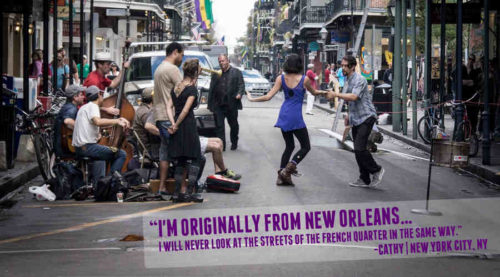
Step away from the famous Bourbon Street to experience the finer things (and shopping!) in life on Royal Street.
Royal Street is the quiet and refined section of the Quarter, a shopper’s paradise with family-owned art galleries, rare antique shops, upscale jewelry, and themed boutiques.
Royal Street is one of the most prestigious and expensive places to shop in the US, so take time to browse the galleries and admire the refinement. Keep your eyes peeled for spontaneous street performers!
Pro Tip: Street Performers on Royal Sreet
Street performers are usually set up on the street along Royal Street. Royal Street is closed to vehicular traffic 11 AM-4-PM on weekdays and 11 AM-7 PM on weekends. With no cars, it’s much easier for pedestrians to safely shop and explore Royal Street during those hours.
One of our favorite performers is Doreen, who plays the clarinet like nobody’s business ; Doreen is out almost every Saturday on the corner of Royal and St. Louis outside the Rouses.
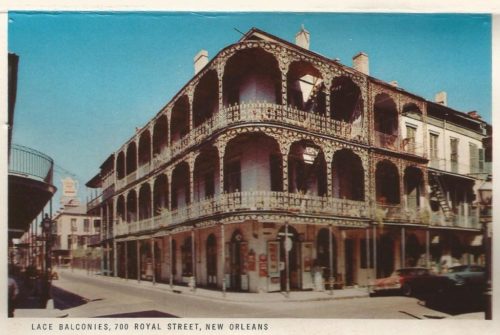
If you’ve ever seen a photo of the French Quarter, you’ve likely seen the iconic LaBranche House. Constructed in the 1830s and turning heads for just as long, the LaBranche House is one of the Quarter’s most photographed buildings. Romantic cast-iron galleries, an elegantly curved shape, and a distinctly whimsical look define the LaBranche House.
The ghosts of LaBranche House
Like most beautiful buildings in the French Quarter, the LaBranche House is surrounded by rumors of hauntings. Built by Jean Baptiste LaBranche, who died before its completion, the house is said to be haunted by Mr. LaBranche’s secret mistress and wife.
After his death, Mrs. LaBranche found out about his mistress and invited her over for tea. The mistress was drugged and chained to the third floor, dying slowly, her body found 15 years later.
It’s said that the ghosts of both these women haunt the building, still feuding.
Take a left down Royal Street. You should be walking towards the large buildings in the distance on Canal street .
More than just a restaurant, The Court of Two Sisters is a must do. It is a famous buffet in New Orleans, absolutely adored by locals and tourists alike! It is a great way to try many of the most famous New Orlean’s signature dishes all at once.
Built during the city’s first economic boom in 1832, the Court of Two Sisters is named for the two sisters that came to inherit it from their father and ran a general store here for many years. It is known for its daily jazz brunches and authentic creole buffet. Take your time and enjoy the beautiful New Orleans courtyard The building also has boutique shops, a small bistro, a refreshment stand, and a speakeasy, that are all worth exploring.
Walk on Royal and take the next left on Toulouse street then a right on Charters.
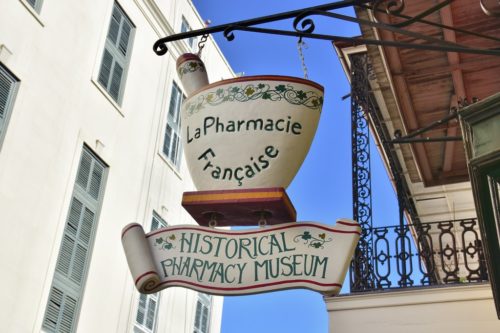
Here’s a one-sentence horror story:
Back in the 19th Century, anyone could apprentice for six months at a Pharmacy and then begin selling their concoctions without any regulations.
During this time, Opium was a standard treatment, as was bloodletting. The wealthy were given pills coated in gold as a “cure-all.” The pills would pass through their bodies often to be retaken once removed from their chamber pots!
These days, the Pharmacy Museum provides educational programs to preserve the past and explain the history of pharmacology in Louisiana.
You may wonder how anyone survived during the 19th century as you tour the Pharmacy Museum! The answer is the smart ones didn’t go to the doctor.
Consider a self-guided tour through the museum to see outdated concoctions strange looking medical instruments and gain a better appreciation for today’s healthcare. Currently open for Self Guided Tours: Weds-Sunday 12pm-5pm check out their website for more info
Hauntings at the Museum
Dr. Gupas, who “imposed shocking experiments on pregnant slaves,” is said to haunt the pharmacy after it closes. There is also a young boy and girl that appear in the courtyard, who are thought to be The Dufilho children.
Pro Tip: We consider The Pharmacy Museum a must do for everyone visiting the French Quarter.
continue on Charters towards St Louis Street.

At over 200 years old, Napoleon House is both a National Landmark and one of the most famous bars in the US.
Napoleon was once offered refuge by the mayor of New Orleans, who lived at 500 Chartres in 1812. Although Napoleon never lived there, the name stuck with the house.
One of the best examples of French architecture in the Quarter, Napoleon House is the perfect place to sip craft cocktails in a palm-shaded courtyard.
If you’re ready for a pick-me-up, grab some red beans and rice, or try a “Primm’s Cup,” a gin-based fruit cup. We also love the muffuletta, a great way to explore the Italian influence in New Orleans.
take a right on St Louis back towards Royal Street.
Established in 1946, Brennan’s Restaurant has perfected the art of blending savory Modern French and Traditional Creole dishes. The happy, pink-colored building is a staple of Royal Street.
The Bananas Foster was born at Brennan’s, created by Ella Brennan and Chef Paul Blangé in 1951. As a hub for Central America, the Port of New Orleans saw an influx of bananas in the 50s, so Owen Brennan challenged Chef Blangé to include bananas in a dish to promote the fruit. The desert was named after Richard Foster, chairman of the New Orleans Crime Commission and friend of Owen Brennan.
Today, Brennan’s Restaurant is said to be extremely haunted. Chef Paul Blangé is known to appear if you order his signature Bananas Foster. The chef is also said to bang together pots and pans at closing time, heard from Royal Street outside the restaurant’s closed doors.
Pro Tip: Brennan’s Restaurant accepts reservations up to 30 days in advance and usually books immediately.
Continue down Royal towards Bourbon street.
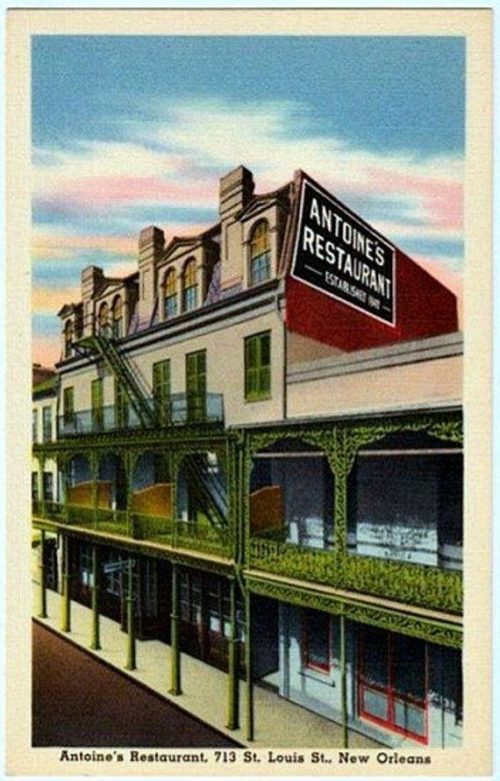
Established in 1840 by Antoine Alciatore, Antoine’s Restaurant is one of the oldest family-run restaurants in the US, passed down through five generations. Besides the award-winning French-Creole food, Antoine’s is known for its prestigious patrons, including US Presidents and Pope John Paul II.
Originally only in French, now also in English, the menu includes famous recipes born in the restaurant itself.
Dishes born at Antoine’s Restaurant:
Oysters Rockefeller Pompano en papillote Eggs Sardou Pigeonneaux Paradis
Antoine’s Cookbook, compiled by fifth-generation descendant Roy F. Guste, has hundreds of original recipes from Antoine’s Restaurant.
continue on St Louis street towards Bourbon Street.
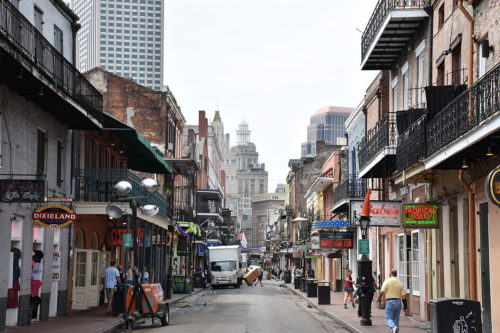
Despite what you’ve heard we think you can’t tour The French Quarter without stopping on Bourbon Street!
For many, Bourbon is what they envision when they think of New Orleans. People swarm the area for the many bars and strip clubs; Bourbon Street sees millions of yearly visitors.
People judge Bourbon Street, and yes, it can get trashy, and yes, it is full of drunks and strip clubs, but it has a fascinating history, and everyone should at least look at it once, preferably during the daytime.
During “the golden age” in the 1960s, clubs acquired high returns by utilizing “B-Girls.” These girls were hired to wander the gambling backrooms and flirt with men to rack up high tabs.
Unknown to the men buying their drinks, the women would be drinking colored water instead of actual brandy (this is where the name B-Girls came from). After ordering several drinks, the women would split, leaving the man with nothing more than a hefty bill to pay.
We wrote an excellent guide to “Things to do in the French Quarter” which includes a list of must do to stops on Bourbon Street
Continue on St Louis and cross Bourbon Street.
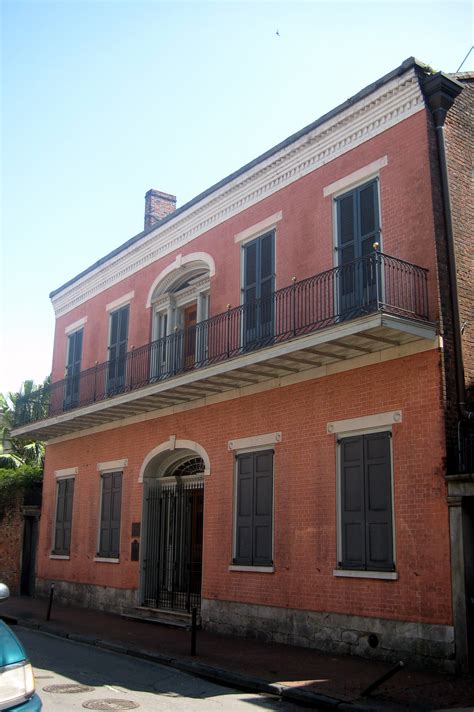
Built in 1831, the Hermann-Grima Historic House is almost 200 years old and is mostly original. It includes slave quarters and an exquisite courtyard.
For the 15th anniversary of the Hermann-Grima Historic House, the museum opened an exhibit called Urban Enslavement in New Orleans , which is well worth a visit.
We think that the Herman Grimma house is one of the best options in the French Quarter for a historic home tour.
continue down St Louis to the next street, Dauphin Street.
Here on the corner of Dauphin and St Louis street is one of the newest additions to the French Quarter. Before historic preservationists put rules in place protecting buildings in the French Quarter, Texaco Oil built a modern “for the times” service station here in 1925.
In 1996 new owners were allowed to demolish the property and build a new single-family home because it was designed to resemble a 19th-century creole townhome with its French Quarter style brick and stucco walls and romantic cast iron Galleries.
Completed in 2001, 500 Dauphine Street is one of the newest buildings in the French Quarter. Take a close look at it. Now look at its neighbor at 835 St. Louis-both are Creole townhomes.
Can you tell the difference?
Take a right on Dauphine away from Canal street.
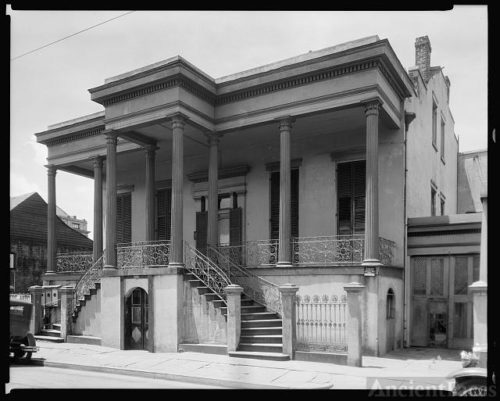
The Xiques House is a historic Greek Revival mansion built in 1852 by J.N.B de Pouilly, New Orleans’s most celebrated antebellum architect.
521 Dauphine makes a statement, towering over the surrounding buildings with elegant pillars. This is one of the few Greek Revivals in The French Quarter, although The Garden District has plenty.
Continue down Dauphine.
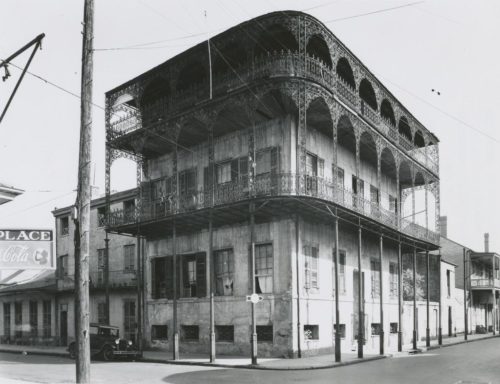
Pretty easy to spot with it’s impressive towering cast iron galleries. Gardette-LePretre Mansion is one of the tallest buildings in the French Quarter today. It was Built for a dentist in 1837. Can you imagine going to a dentist in 1837? absolutely terrifying! Today this is a 6 unit apartment building.
take a right and walk down Orleans Street towards Bourbon Street. You should be able to see “Touch Down Jesus” from here
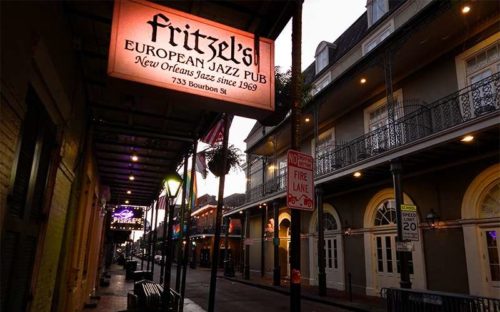
Fritzel’s European Jazz Pub is the oldest jazz club on Bourbon Street!
Along with Preservation Hall on St. Peter Street, Fritzel’s is one of the few places on Bourbon Street to catch live jazz music nightly. It opened in 1969. Fritzel’s has a much more laid-back atmosphere than the rest of Bourbon Street, so stop by, grab a drink and enjoy getting lost in the music. If you’re a jazz fan, this place will light your soul on fire.
Want to watch more live music while visiting New Orleans? Check out our Guide to Live Music in New Orleans .
OZ is the #1 LGBTQ dance club in New Orleans, located on Bourbon Street. Featuring different events every night of the week, this 21+ dance club has two floors with a classic Bourbon Street balcony for people watching.
Expect a friendly crowd, loud music, a full bar, and a balcony that you can sit on for that classic New Orleans Bourbon Street balcony bucket list experience.
Across the street is The Bourbon Pub, another gay bar/dance club. This stretch of Bourbon Street is historically a gay neighborhood.
Cafe Lafitte is the oldest LGBTQ bar in the south opened by Roger Caplinger after he lost the original Cafe Lafitte’s (currently Lafitte’s Blacksmith shop) in a tax sale. This is considered by many the oldest gay bar in the south. Tennessee Williams and Truman Capote were frequent patrons of the cafe. Many of the people who renovated, restored, and saved the properties in the French Quarter were gay men who frequented this bar “back in the day”.
Continue down Bourbon Street away from Canal Street.
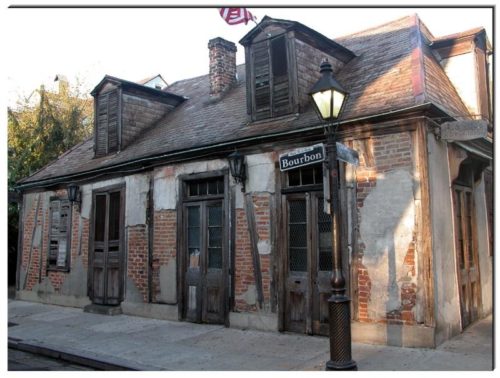
While its claim as the oldest bar in America is debatable (the building didn’t open as a bar until the 1940s), Lafitte’s Blacksmith Shop Bar is likely the oldest building in America with a bar in it.
Named for the Pirate Lafitte, whose brother owned this shop at the height of their Piracy and smuggling operation and were believed to use the business as a front for their pirate operations.
This location used to be Cafe Lafitte, which Roger “Tom” Caplinger opened during the late 40s. Caplinger was big in the queer community and hosted drag shows attended by the likes of Truman Capote, Noel Coward, and Tennessee Williams.
Caplinger never held the deed to the location, and the cafe was sold in 1953. Not to be deterred, Caplinger bought another building and named it Cafe Lafitte in Exile, a block away from the current Lafitte’s Blacksmith Shop Bar in the early 1960s.
Lafitte’s Blacksmith Shop is exclusively lit by candlelight, complimenting the live piano music. That’s our tour, so sit down and get yourself a drink or read on for tips for things to do and where to eat.
Pro Tip: The “Voodoo Daiquiri” or “purple” drink is highly recommended for first-timers, especially on hot days. It’s rumored that the ghost of Lafitte himself occasionally appears near the fireplace.
Where to Watch Street Performers
The best place to find street performers in The French Quarter are:
Royal Street – Musicians perform at all times of the day. From poets to hire to solo blues guitarists, instrumental guitar/violin duets, gypsy jazz, and more, this is the heaviest concentration of street musicians in The French Quarter. Frenchman Street – there are over a dozen venues with live music to be heard indoors. Jackson Square – stop in front of the Presbytere and the Cabildo, where it’s commonplace to encounter a brass band or two, violinists, or even a lone saxophonist. Take a Free Music Tour- We at Nola Tour Guy have put together a Free Guide on where to see live music in New Orleans . We cover all the best music joints in the Crescent City.
After exploring the history and magic of The French Quarter, relax the New Orleans way: with a crafted cocktail, preferably in a romantic courtyard or patio. Here are some of the must-try cocktails that The French Quarter is known for:
The Hurricane
The Hurricane is a sweet red cocktail traditionally served on ice. Created during World War II, the name comes from the shape of the glass it was originally served in, which resembles a hurricane lamp. Pat O’Brien’s is where it was born! The courtyard at Pat’s is a must-do; with dueling pianos and a timeless atmosphere, you won’t be disappointed. Note: the Hurricane doesn’t taste strong, but it is. Take it slow to avoid feeling like you got hit by a hurricane the next day.
The Sazerac
Created in 1835 by Antoine Peychaud, the Sazerac is the first official cocktail in the world. The drink is rye whiskey, bitters, and Absinthe, so it was banned in 1912 when Absinthe was made illegal in the United States. Herbsaint, an anise-flavored liqueur, was created as a substitute in 1934 by a local company so New Orleanians could still enjoy this cocktail. Enjoy this potent concoction at the Sazerac Bar. Use Sazerac the intended way- a digestif, an after-dinner drink to aid digestion.
Vieux Carre
Vieux Carre is a classic French Quarter cocktail, first mixed in 1938. Try this traditional drink at the famous rotating Carousel Bar in the Hotel Monteleone, where it was created! This cocktail is a compelling blend of whisky, cognac, vermouth, and bitters.
Henry C. Ramos first mixed the Gin Fizz in 1888 at Meyer’s table D’Hotel Internationale. The frothy cocktail needs fifteen minutes of vigorous shaking, which required Ramos to hire “shaker boys” due to the high demand. Louisiana Governor Huey Long loved this drink so much that he brought his bartender with him when traveling to New York so he wouldn’t be without his favorite drink. Ramos sold the rights to the Roosevelt Hotel after the Prohibition, so if you want the original version, this is your stop.
Created in World War I, the French 75 is named after the French military’s M1897 rapid-fire 75mm artillery gun because it packs such a powerful kick. This simple Champagne cocktail has a light citrus taste and can replace a typical mimosa with so many variations available.
Our guide to Planning your Trip to New Orleans
Let us help you plan your trip to New Orleans. We are experts of all things New Orleans and we’ve been putting our knowledge together into a guide. This guide is a collection of articles that can act as a free trip planning guide giving you an idea of some of the best things to do, tours that are worth your time and money, places to see and where to eat. So check out our free trip planning guide.
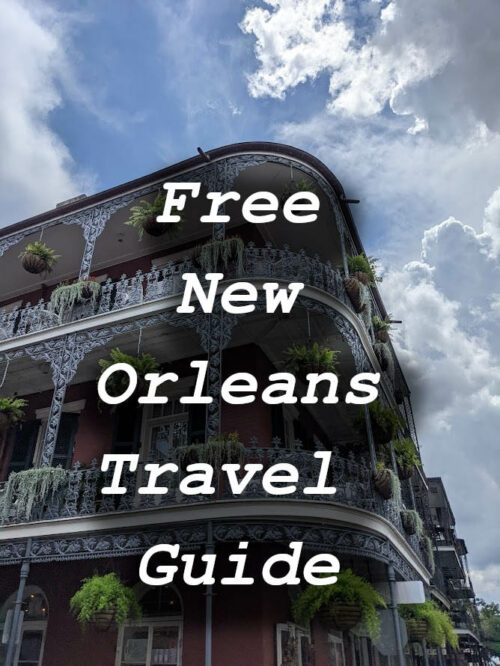
What we are about
Nola Tour Guy is a collective of passionate guides, both men and women, who are experts in the history of New Orleans. Our goals are to give tours that are intellectually stimulating, historically accurate and FUN. We only offer walking tours because we believe that walking is the best way to see a city and learn about it and at a price everyone can afford. Nola Tour Guy offers no novelty tours only the real history brought to life by our passionate guides. Join us, you won’t be disappointed..
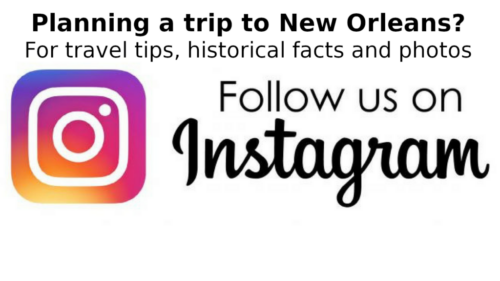

New Orleans > Free French Quarter Walking Tour
New Orleans Tourist Tips | Suggested Itineraries For New Orleans
- New Orleans
- Top 10 Things To Do
- French Quarter Walking Tour
- Garden District Walking Tour
- Plantation Mansions
- Frenchmen Street
- Top 10 Must Eats
- Top Ten Must Drinks
- Other Sights
- Best Day Trips
- Helpful Tourist Advice
- Suggested Itineraries
- Madri Gras Tips

French Quarter Walking Tour:
Location : French Quarter New Orleans Cost : Free, Self-Guided ( Optional costs listed below ) Style : Do-It-Yourself Walking Tour ( Self Guided ) Starting Point : Washington Artillery Park & Terrace End Of Tour : The Carousel Bar Walking Distance : 2.5 miles of walking ( -0.5 if you skip stops 9-13 ) Time Required : 2 Hours of walking ( +a few hours for food and drink ) Fun Scale : 9.5 out of 10
Overview of the French Quarter:
Our free, self-guided French Quarter walking tour will put you in the center of the cultural heartbeat of New Orleans for an unforgettable experience. Originally called the Vieux Carré ( pronounced Vue Ca-Ray ), or Old Square in French, the French Quarter has vibrant roots dating long before New Orleans was officially founded in 1718. From local Native Americans as early as 400AD to European settlers and slaves centuries later, the French Quarter grew as a blend of many cultures. By its heyday in the mid-1800s, the French Quarter was a thriving melting pot of French, Spanish, African, Native-American, and Creole heritage.
Today the unique mix of culture shines through the French Quarter with bursts of colorful festivals, hints of voodoo, live jazz music, an unbeatable bar district and some of the best food in the country. New Orleans is often considered the most unique city in the world and its all on display in the French Quarter. We hope you enjoy our do-it-yourself French Quarter walking tour!
French Quarter Walking Tour Sights:
1. washington artillery park & terrace ( 768 decatur street ):.

About Washington Artillery Park : While often overlooked by tourists, we love to start our French Quarter walking tour on the perch of Washington Artillery Park & Terrace. The park is actually on top of a levee that was enhanced in the 1800s to protect New Orleans from the flood waters of the Mississippi River. With its elevated position over Jackson Square to one side and the mighty Mississippi River on the other, the stunning views from the terrace really help you get a lay of the land. It is no wonder that this position was used by the French, Spanish, Confederates, and Americans to defend New Orleans over the centuries. A memorial in the middle of the terrace pays homage to its history as a military battery with a Civil War-era cannon always on guard. The cannon is a model 1861 Parrot Rifle used in the Civil War and is dedicated to the local 141st Field Artillery of the Louisiana National Guard.
Looking toward the Mississippi River from the terrace, you’ll see a delightful waterfront walking path known locally as the Moonwalk. If you hunt you for it, will also find a marker for the New Orleans Steamer which landed here in 1812 as the 1st steamboat to navigate both the Ohio and Mississippi Rivers to the Gulf of Mexico.
Before leaving the terrace, make sure to take in the perspective of the Saint Louis Cathedral and the horse-drawn carriages that line the front of the Jackson Square below you. A ton of carriage companies are available on standby to take you anywhere you want in the French Quarter and Garden District, but our favorite is Royal Carriages ( website ). As you descend toward the carriages, make note of the stepped amphitheater where you can often watch some great street performers in action.
2. Jackson Square ( 700 Decatur Street ):
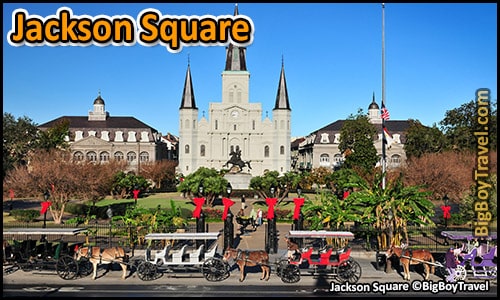
About Jackson Square : For as much fanfare Bourbon Street gets, the real heart of New Orleans has always been Jackson Square. Soon after the French founded the city in 1718, they began carefully planning New Orleans around this large central square which was originally called Place d’ Armes ( meaning Weapons’ Square ). The square, which opened in 1921, was modeled after the famous Place de Voeges in Paris and the location was selected because of its close proximity to a longstanding Native American trading post.
Today’s French Quarter neighborhood, first known as Vieux Carré ( meaning the Old Square ), was quickly built out around the Place d’ Armes in a clean grid system. From the start, the main square quickly turned into an important gathering point in early New Orleans life. France’s influence on the city was further highlighted by the construction of the Catholic Saint Louis Church on the North side of the square along with the adoption of the French language.
After a series of crippling wars in Canada and Europe, the French had to transfer all of the Louisiana Territory under Spanish control in 1762, which was cemented by the Treaty of Paris. The name of the central square stayed intact ( Plaza de Armas ) and local French influence on culture remained strong as Spain chose to rule Louisiana at an arm’s length away from Cuba. France eventually got Louisiana back from Spain, but in less than a year, Napoleon sold the entire territory to the United States in 1803 through the Louisiana Purchase .
Even though America “owned” the entire Louisiana Territory and started forming new states out of it, they didn’t fully control it until they withstood British attacks in New Orleans as part of the War of 1812 . This war came to a climatic end when the United States won the Battle of New Orleans in 1815 under the leadership victorious General Andrew Jackson .
During the War of 1812, Andrew Jackson had consulted with local pirates in New Orleans for the planning of the battle and then paraded over 6,000 troops in celebration around Place d’ Armes after they won. It was this victory that made Jackson a national war hero and propelled his political career all the way to the United States Presidency ( U.S. President from 1829-37 ). In 1856 a large statue of Andrew Jackson triumphantly riding on a horse was unveiled in the center of the square which was renamed Jackson Square in his honor. In early day New Orleans, public executions commonly took place in the area of the square where the beautiful statue now sits.
Hours : Gates are open Daily 8am-7pm ( until 6pm in the Winter ). Cost : Free.
3. Saint Louis Cathedral ( 615 Pere Antoine Alley ):
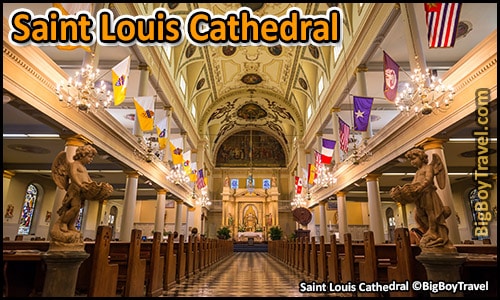
About Saint Louis Cathedral : Built in 1727 on the site of a hurricane-damaged parish, the Saint Louis Church was dedicated to the sainted King of France, Louis IX from the 1200s. The church helped to better establish Catholicism in the Louisiana Territory to contrast the largely Protestant United States. Tragedy struck when a massive blaze known as the Great Fire of 1788 badly burned the church and 855 other buildings in the French Quarter. Luckily the church was quickly rebuilt thanks to funding nobleman Andrés Almonaster who also funded stops 4 & 5 of this walking tour. The new Spanish-style church was declared a Cathedral soon after it opened on Christmas Eve, 1794. The timing was perfect as the public badly needed the Church for moral support as earlier in the month the Great Fire of 1794 struck the heart of New Orleans and burned 212 buildings. This led the Spanish to get away from wood and start building with brick and rod iron which can still be seen all over this free French Quarter walking tour.
As support beams were removed during a facade update in 1849 the roof collapsed, the walls developed cracks, and much of the Cathedral had to be demolished. The following year a redesign began with heavy French architectural influences and the only main element they were able to salvage from the Spanish church was the central tower’s bell. The final result of the relentless rebuilding is today’s breath-taking Saint Louis Cathedral, now designated as a basilica, which has become the most iconic landmark in all of New Orleans. Make sure to check out the interior with its checkerboard tile floor and stained glass window depicting the life of King Louis IX including the 7th Crusade. The flags hanging from the interior balconies on the right show the countries New Orleans has been under since 1718, while the left side has various Papel crests.
During Hurricane Katrina in 2004, two large oak trees in St. Anthony’s Garden on the backside of the Cathedral was ripped up along with portions of the Cathedral’s roof. The hole in the roof allowed water to damage the pipe organ which required a lot of restoration. You can still see some of the damage while in the garden behind the church where a marble statue of Jesus lost a finger and a thumb. Even with the missing fingers, the statue has awesome lighting that at night casts a larger than life shadow onto the backside of the Cathedral. The easiest way to reach the Garden is by walking down Pirates’ Alley which we will visit later on this tour. The most celebrated moment in the history of the St. Louis Cathedral was the visit of Pope John Paul II in September 1987, although Pope Paul VI also stopped by in 1964.
Cathedral Website : ( HERE ).
4. The Cabildo ( 701 Chartres Street ):
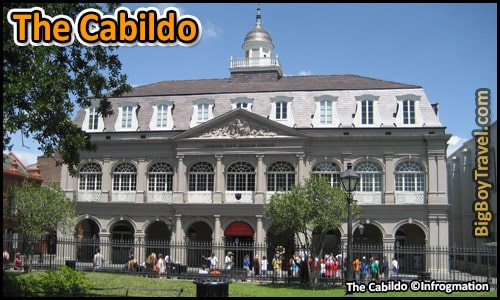
About The Cabildo : The grand Cabildo was built in 1795 as the new New Orleans City Hall after the old building burned in the Great Fire of 1788. The name come from the Illustrious Cabildo ( City Council ) who would meet here during the years Span controlled Lousiana. It was kind of a weird time for the local government as they spoke Spanish while the residents continued to speak French. Famously, The Cabildo as the location of the signing of the Louisiana Purchase when the French sold the Louisiana Territory to the United States in 1803 less than one month after getting it back from Spain.
The building also served as the home of the Louisiana Supreme Court where the nationally significant decisions in both the Slaughterhouse and Plessy vs. Ferguson cases were handed down in the late 1800s. We love the details from this period of history on the facade including the huge relief of an American eagle with cannonballs which replaced an image of the Spanish coat of arms in 1821.
Since 1911, The Cabildo has been the flagship building for the Louisiana State Museum. Exactly two hundred years after it first burned down, The Cabildo was once again severely damaged by fire in 1988. Thankfully the building was beautifully restored using 600-year-old French timber framing methods and in 1994 reopened to the public with exhibits focusing on Louisiana’s early history. There are excellent topics to explore ranging from local Native American history, to colonial events, the and the Civil War. Our favorite item on display is Napoleon’ Death Mask from 1927 which was given to the city by France because Napoleon died on his way to New Orleans while seeking shelter during his exile.
Cabildo Museum Hours : Tuesday-Sunday 10am-4:30pm. Admission Cost : Adults $6, Children Free ( Purchase tickets for 2 or more city museums and get 20% off ). Museum Website : ( HERE ).
5. The Presbytère ( 751 Chartres Street ):
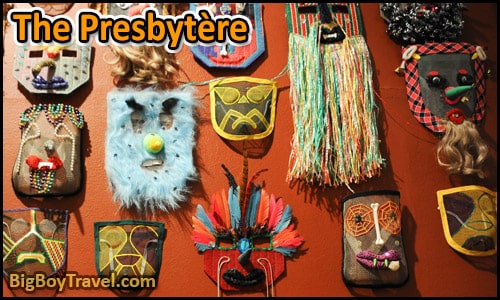
About The Presbytère : Flanking the Eastside of the Saint Louis Cathedral as a mirror bookend to The Cabildo is the timeless Presbytére. This stunning building was completed in 1791 on the former site of the residence ( presbytére ) of the local Capuchin monks which had been damaged in the Fire of 1788 like much of the French Quarter. The new Presbytére building served as a home for local clergy and was known as the Casa Curial ( Ecclesiastical House ) . Construction delays really hampered the completion of the Presbytére as the 2nd floor wasn’t finished until 1813 and the 3rd floor in 1847, more than 50 years after the project started. The church finally sold the Casa Curial in 1853 and it became part of the Louisiana State Museum in 1911.
Our favorite exhibit at the Presbytére Museum is one highlighting the history of Mardi Gras with many stories, masks, party favors, souvenirs, invitations, and more all displayed in huge open storage cabinets. The most dazzling exhibit is probably the Crown Jewels Vault with an astonishing array of tiaras, scepters, necklaces and other baubles worn by generations of royalty. Artifacts in the main exhibit focus on the aftermath of Hurricanes Katrina and Rita in 2005, provide an unforgettable experience of loss and devastation.
Presbytere Museum Hours : Tuesday-Sunday 10am-4:30pm; Closed Mondays. Admission Cost : Adults $6, Children Free ( Purchase tickets for 2 or more city museums and get 20% off ). Museum Website : ( HERE ).
6. The Pontalbas & 1850 House ( 523 Saint Ann Street ):
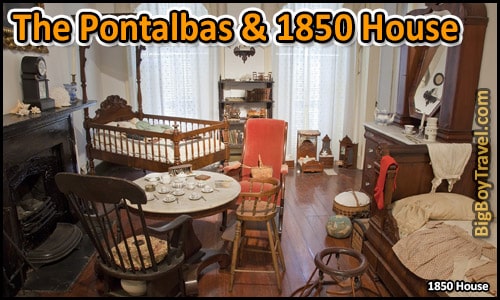
About The Pontalbas : Running along each side of Jackson Square are massive one block long, 4 story tall red brick complexes built in the 1840s by Baroness Micaela Pontalba . The Baroness spent in upwards of $300,000 on the buildings which were constructed in honor of her father Andrés Almonaster. Her father was a Spanish colonial landowner who helped finance the current versions of The Cabildo, Saint Louis Cathedral, and The Presbytère we just visited on this free French Quarter walking tour.
Known today as The Pontalbas, the buildings were originally used as townhomes, but were later divided into upper-level apartments with lower level shops after the Great Depression. To help give you a glimpse into what upper-class life was like in antebellum era New Orleans ( 1840-50s ), the city set up a living museum called 1850 House. Furnished with everyday items, decorative art, and clothing from the period, the 1850 House does a great job of depicting upper-middle-class family life during the most prosperous period in New Orleans’ history. If you are trying to prioritize your time, keep in mind that later on this walking tour there are three other excellent period homes you can also tour including the Hermann-Grima House, Merieult House, and Gallier House.
1850 House Hours : Tuesday-Sunday 10am-4:30pm. Admission Cost : Adults $3, Children Free ( Purchase tickets for 2 or more city museums and get 20% off ). 1850 House Website : ( HERE ).
7. Cafe Du Monde ( 800 Decatur Street ):
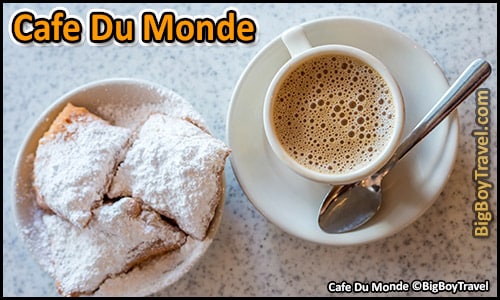
About Cafe Du Monde : Any time you go to New Orleans one of the first questions your friends will ask is, “Did you get a beignet at Cafe De Monde?” Beignets are square French-style doughnuts, lavishly covered with powdered sugar and they are delicious.
Cafe Du Monde, established in 1862, is also known for its strong coffee served both Black and Au Lait . Au Lait coffee means that it is mixed half and half with hot milk. We highly suggest trying their Chicory Root Coffee which is a unique blend of coffee grounds mixed with the bitter chicory root of the endive plant. The coffee was made very popular after the Civil War because coffee was scarce and the root added flavor to the brewing process. Normally served Au Lait, the root added an almost chocolate flavor to your coffee.
Keep in mind that Cafe du Monde is so popular that the walk up line to buy beignets can often be a full city block long in the mid to late afternoon, especially on the weekends. If you want a manageable line or a sit down spot inside the cafe you will want to visit early.
Cafe Hours : Daily, 24 Hours. Cafe Website : ( HERE ).
8. Decatur Street ( 900-1100 Decatur Street ):
About Decatur Street : As you leave Cafe Du Monde and stroll down Decatur Street you’ll find the best deals in town on your tourist souvenirs. Although there are fancier shops and art galleries on Royal Street later on this free French Quarter walking tour, Decatur Street has a dense collection of great tourist shopping even though some of it is tacky. The road was originally called Levee Street, but after the Mississippi River altered course in 1870 the levee located here was no longer needed and the street was renamed in honor of the naval hero Stephen Decatur.
At the start of the tourist shops, you’ll run into the Central Market Deli ( 923 Decatur, website ) which is famous for inventing the Muffaletta , a delicious Italian deli sandwich that makes a get a snack or lunch to go. We have the Muffaletta sandwich as one of our Top Ten Must Eats In New Orleans . Another favorite place of ours to grab food in the area is BB King’s Blues Club ( 1104 Decatur, website ) which also has excellent live music. The nearby Crane & Table Restaurant ( 1113 Decatur, website ) is very well known for their great brunch and bottomless drinks.
Make sure to check out the golden Joan of Arc statue in the middle of the small Latrobe Park while walking along Decatur Street. Gold is the official color when she is honored with a parade here every January 6th as an unofficial patron saint of the city. Joan’s time in France in the 1400s mirrors New Orleans own battles against the British as she had famously liberated the citizens of Orleans, France from British siege.
After Dark: The stretch of Decatur Street between Dumaine Street to Esplanade Avenue can feel a bit seedy after dark, but is perfectly fine during the day and early evening.
9. French Market ( 1008 N. Peters Street ):
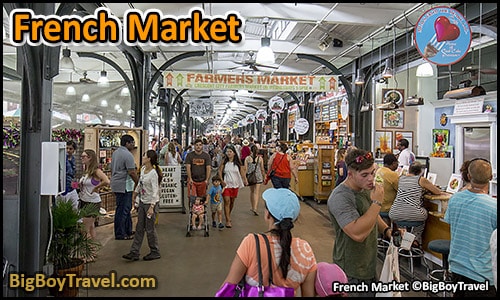
About The French Market : What began as a Native American trading post and portage point on the banks of the mighty Mississippi River, was turned into a full market by French settlers in 1791 making the French Market America’s oldest public market . Over its long history, the French, Italians, Spanish, Portuguese, Moors, Irish, English, and Dutch have jockeyed for market share in the French Market making it a cultural melting pot. The melting pot nature of the covered French Market lets you can find pretty much anything here as the Market serves as a Bazaar, Butcher’s Market, Seafood Market, Flea Market, Vegetable Market, and Farmers’ Market with a peppering of restaurants and shops.
Market Hours : Flea Market Daily 7am-7pm, Farmer’s Market Daily 9am-7pm. After Dark : The stretch between stops 9-13 can get a little shady after dark with you aren’t with an official tour group and you may feel safer sticking to just the stops around Jackson Square, Royal Street, and Bourbon Street if it’s getting late. Since the French Market is closed at 7pm it shouldn’t really be an issue anyway. Market Website : ( HERE ).
10. Old United States Mint & Jazz Museum ( 400 Esplanade Avenue ):
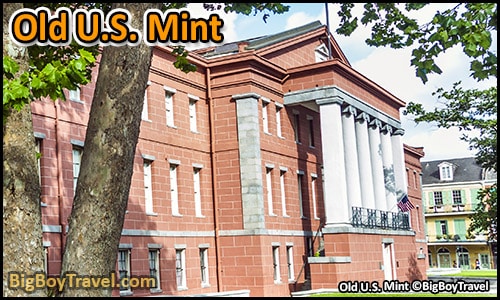
About The Mint Museum : The Old United States Mint is the only building in America to have served as a mint for both the United States and the Confederate States . The Mint was built in 1835 under President Andrew Jackson, who had advocated for its establishment in order to help finance development of the nation’s Western frontier. Jackson was always a huge supporter of coins and gold over paper money.
Now serving as a Museum, the 1st floor of the Mint houses an amazing collection of both Confederate and Union money while the 2nd floor is home to the New Orleans Jaxx Museum complete with a ton of instruments. We have always felt that the Mint was built backward as the cool columned facade side of the building faces away from the French Quarter. One block away is the lively Frenchmen Street which has amazing jazz clubs with live music in the evenings.
Hours : Tuesday-Sunday 10am-4:30pm. Cost : Adults $6, Children Free ( Purchase tickets for 2 or more city museums and get 20% off ). Jazz Museum Website : ( HERE ).
11. Old Ursuline Convent ( 1100 Chartres Street ):
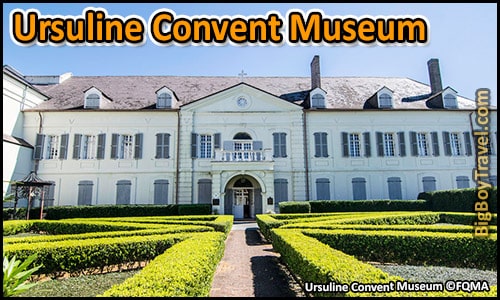
About The Old Ursuline Convent : With a storied past, the Ursuline Nuns were the first religious order to arrive in Louisiana when they landed in 1727. The nuns’ first convent building was half-timbered which didn’t fare well in the humid climate of New Orleans and was a bit of a fire hazard. The deteriorating structure was replaced by today’s impressive brick and stucco Colonial-style convent in 1751. With tales of vampires and casket girls , this eerie three-story convent is known for its intense stories of hauntings.
With a largely male population in the mid-1700s the King of France started to send poor and orphaned ladies from French convents to New Orleans. Each girl was sent over with a casket shaped chest said to hold their belongings which were to be held in storage on the 3rd floor of the Ursuline Convent until the girls found an acceptable suitor. Often looking sickly after 5 months at sea, and donning caskets, rumors that the girls were vampires or brought vampires with them started quickly. Some of the girls did find husbands, but many fell in prostitution or were never heard from again. With the local death rate starting to rise, the girls’ casket chests were found to be empty and the shutters of the 3rd story windows were sealed up out of fear. It’s said that the Pope himself blessed the nails to keep in the evil and they remain closed to this day.
The sitting just across the street from the convent, the Beauregard-Keyes Mansion was built in 1826 a year after the Ursuline Nuns moved to a new convent starting to sell off their extra property. During the Civil War the Greek revival mansion was home to Pierre Gustave Toutant-Beauregard, who was the first prominent general of the Confederate States Army. Was later home to author Frances Parkinson Keyes.
Convent Hours & Tours : Free self-guided tours available Monday through Friday, 10am-4pm; Saturday 9am-3pm; last admission 45 minutes before close; Closed Sundays. Convent Website : ( HERE ). Keyes Mansion Hours & Tours : For $10 the home and garden (added in 1833) there are tours each hour from 10am-3pm on Monday-Saturday. Keyes Mansion Website : ( HERE ).
12. Madame LaLaurie’s Mansion ( 1140 Royal Street ):
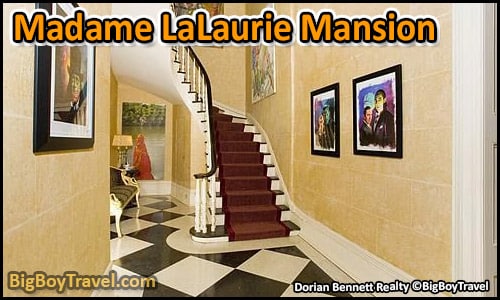
About Madame LaLaurie’s Mansion : This creepy 3 story mansion was built in 1831 by the infamous Delphine LaLaurie and is considered to be the most haunted house in New Orleans . The twice-widowed Delphine, known as Madame LaLaurie, was fresh on a new marriage to a local doctor when something evil started brewing. The LaLaurie’s neighbors were the first ones to suspect that something was wrong and that Delphine was potentially a sinister woman . They noticed that the LaLaurie family’s house slaves seemed to disappear often and that parlor maids would be replaced at will. Some servants who disappeared were said to have committed “suicide” and one of their prominent stable boys suddenly vanished, never to be seen again.
he suspicions started coming to light one Summer’s day when a neighbor heard a scream and saw Delphine chasing a young servant girl with a whip. The girl fled to the roof for safety, but when Delphine continued to come after her, the girl jumped to her death . The same neighbor later claimed to see the small slave girl being buried in a shallow grave beneath a tree in the yard. It is said that even today the girl’s screams can still be heard from time to time.
The most gruesome discovery happened on April 10th, 1834 when a fire broke out in the home and neighbors burst in to help. What they found on the top floor were a dozen starving slaves chained to tables, the walls, and even in cages. Some of the slaves had their guts hanging out, others their lips stitched shut, and many others missing limbs. As the neighbors ran after Delphine, calling for her head, she quickly jumped in her carriage to never be seen again. The creepy history is part of the draw that got actor Nicolas Cage to own the home from 2007-09. The story of Madame LaLaurie goes further attention when she becomes the main character of an entire season of the hit TV show American Horror Story .
13. Gallier House ( 1132 Royal Street ):
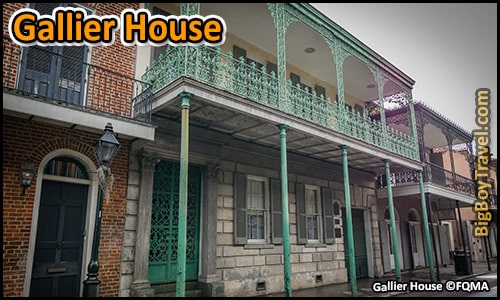
About The Gallier House : In the mid-1800s, James Gallier was one of New Orleans’ most prominent architects. His design work found an enthusiastic audience of civic leaders, businessmen, and affluent families. You will enjoy a stroll through Gallier’s elegant Victorian home, restored to reflect the lifestyle of a successful urban designer in pre-Civil War New Orleans. Local author Anne Rice was inspired by the Gallier House and used it as the home of Lestat and Louis in her famous novel Interview with the Vampire . It’s said that Rice was inspired by the stories of Count Saint Germain , son of the Prince of Transylvania, and one of New Orleans’ most famous vampires. The Count was said to be an immortal man possible 500 years old who lived nearby at the intersection of Ursulines and Royal. In 1902, a girl tried to escape him by jumping off the balcony but he got away. When authorities arrived they found no dishes in the home but did find 17 bottles of human blood said to have over 100 strands of DNA.
In addition to its vampire fame, the exterior of the Gallier was also used as the facade of the Madame LaLaurie Mansion in the hit TV show American Horror Story . The same owners of the Gallier House also own the Hermann-Girma House which we will visit later in this free French Quarter walking tour. Their other home was also featured in American Horror Story as the interior of the Madame LaLaurie Mansion. We love touring both of these fabulous homes in the same day.
Hours & Tours : Monday, Tuesday, Thursday, Friday hourly tours run from 10am-3pm; Wednesday tours by appointment only; Saturday hourly tours 12pm-4pm; Closed Sundays. Admission Cost : Adults $12, Children $10 ( you can add admission to the other home they manage at Stop 27 for $8 ). Museum Website : ( HERE ).
14. Lafitte’s Blacksmith Shop Bar ( 941 Bourbon Street ):
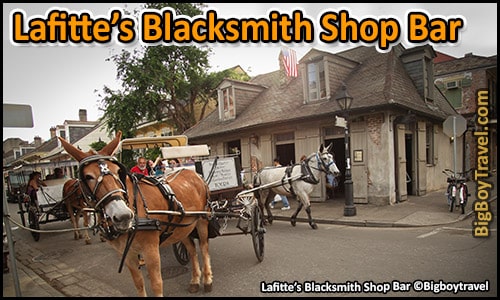
About Lafitte’s Blacksmith Shop Bar : With fireplace heating and no electric lights, a visit to Lafitte’s Blacksmith Shop Bar will make you feel like you are stepping back in time. Built between 1722 and 1732 as a cottage-like home for Nicolas Touze, the historic tavern is considered the Oldest Bar in the American South. From 1772-1791 the Blacksmith Shop served as a hideaway for Jean Lafitte ( pronounced Zhah La-feet ) and his band of pirates who posed as blacksmiths while they smuggled goods in from the Caribbean. The smuggling operation was widely held under wraps by locals as New Orleans was under Spanish rule at the time and a trade embargo made it hard to get some goods in.
Jean Lafitte later became a national hero when he used his pirate expertise to help General Andrew Jackson defeat the British in the Battle of New Orleans in 1815 . With American troops outmatched and undersupplied, Lafitte secretly smuggled supplies to the Americans giving them the edge to win the Battle. After his good deed was done Lafitte then sailed off to new adventures and the Blacksmith shop became a full-time tavern. The tavern is our favorite stop on this free New Orleans walking tour.
You may notice that the architectural style of the Blacksmith Shop looks quite a bit different than most of the other houses in the neighborhood. This is because a slate roof and brick helped to protect the Blacksmith Shop from the great fires in 1788 and 1794 which destroyed hundreds of the neighboring wooden homes. With Spanish rule at the time of the fires, many of the rebuilt homes nearby had more of a Spanish influence compared to the old French cottage. To this day the Blacksmith Shop still rolls old school with no electric lighting, allowing its fireplace, romantic candlelight, and live music make it a truly magical place to have a drink after dark. While they have a wide selection of drinks, our favorite it the purple frozen Voodoo Blend that comes right out of an old school slushy machine.
Keep an eye out for other buildings in this style as you make your way further down Bourbon Street our free French Quarter Walking Tour. While many of the other bars on Bourbon Street were also historic homes, most weren’t converted into bars until the late-1800s and have been heavily modernized inside. The name Bourbon Street predates these bars as it was named after the royal Bourbon Family of France and not the alcohol. It is also said that the bathroom of the Blacksmith Shop is haunted.
Blacksmith Bar Hours : Open daily until late. Blacksmith Bar Website : ( HERE ).
15. New Orleans Voodoo Museum ( 724 Dumaine Street ):
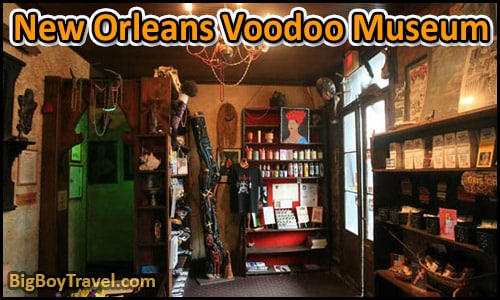
About The New Orleans Voodoo Museum : Really, no one grows up in New Orleans without being exposed to the culture of Voodoo. In the case of Charles Massicot Gandolfo, the Voodoo Museum’s founder, it was a little stronger with tales that his great-grandfather had been raised in New Orleans by a real Voodoo Queen . An artist, with a passion for all the history and romance of New Orleans, Charles opened this museum in 1972 to share his fascination with the world. Taking all the mysteries, the secrets, the history and folklore of rituals, zombies, and gris-gris of the Voodoo Queens, Charles put it all in one place in the heart of the New Orleans French Quarter. This is a worthwhile stop if you want a better introduction to Voodoo than the souvenir shops give. Cameras, photographs, and questions are always welcome and encouraged.
Hours : Daily 10am-6pm. Cost : $7 for Adults; Children $3.50; Admission is FREE if you do their $19 Voodoo walking tour. Museum Website : ( HERE ).
16. Cornstalk Hotel ( 915 Royal Street ):
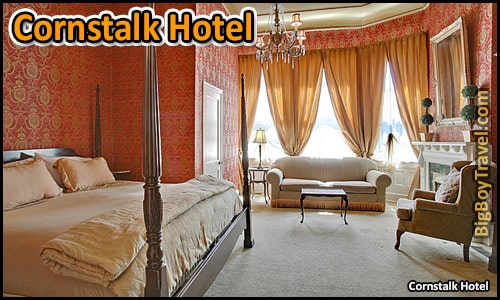
About The Cornstalk Hotel : This elegant yellow hotel is one of our favorite homes in the French Quarter. Judge Francois Xavier Martin, author and first Attorney General of State of Louisiana , built the Cornstalk in 1816 and lived here until 1826. Doctor Joseph Secondo Biamenti purchased the mansion in 1834, turned it into a hotel, and added its famous cast iron Cornstalk Fence in 1856. The fence is truly a landmark that in itself has helped make the old French Quarter famous. Your gaze will be drawn to the fence’s beautifully ornate and delicate iron handicraft. Ripe ears of corn on their stalks are seemingly ready for the harvest, each kernel a work of art. Pumpkins form the base of the iron columns around which are entwined by pumpkin vines and the leaves and morning glories. Look for the yellow butterfly on the front gate.
Famous guests at the hotel include Bill & Hillary Clinton, and even the “King” himself…Elvis Presley. Among many famous hotel guests, Harriet Beecher Stowe allegedly stopped here and was inspired to write Uncle Tom’s Cabin from the sights at nearby slave markets. The novel was later a major influence on the starting the Civil War. Speaking of famous guest, the neighboring Nine-O-Five Royal Inn ( 905 Royal St ) claims to have been a place where Rip Van Winkle slept. It’s hard to believe this claim though since the fictional story of Rip was actually written in and based in England. Also, make note of the Romeo spikes on the gallery posts across the street ( 910 Royal ) which are decorative, but also to stop intruders. Famously in 1904, a man who was sleeping with the red-headed lady that lived her tried to slide down the pole to escape her fencing champion father and was split wide open.
Hotel Website : ( HERE ).

17. Madame John’s Legacy ( 632 Dumaine Street ):
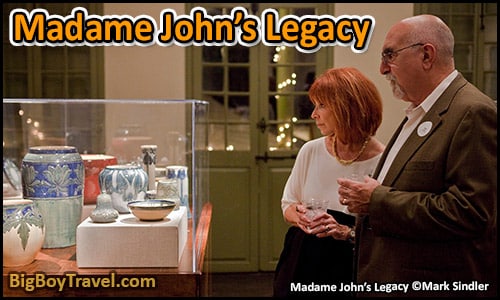
About Madame John’s Legacy : After the Great Fire of 1788, this timeless home was built on the ashes of the previous home that dated back to 1725. Shortly after the new construction was finished, it ended up being one of the only houses in the area that escaped the Great Fire of 1794 . The name Madame John’s Legacy came much later from a story called Tite Poulete, written in 1879 by author Geo Cable Madame about the previous home that once stood here. John’s Legacy is an excellent example of Louisiana Creole design from the end of the 18th century which mainly only survives today deep in the bayou. Before the second great fire in New Orleans, it was commonplace to see many homes in this style all over the French Quarter.
Museum Website : ( HERE ). Hours : Currently closed for 2019 for renovations but you can see it from the outside.
18. Royal Street Art Galleries ( 731-841 Royal Street ):
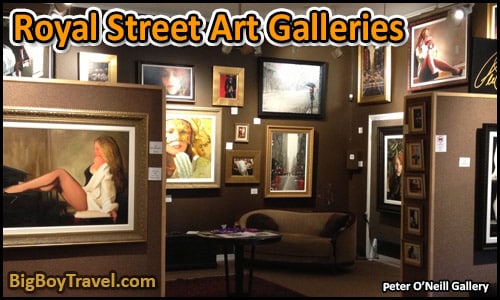
About The Royal Street Art Galleries : In contrast to the sometimes grimy Bourbon Street bar scene, Royal Street offers a much higher quality shopping and tons of funky artist galleries. While the art is fairly expensive, the classy galleries are a pure joy to wander through. With a wide selection of sculptures and paintings, our favorite pieces are mixed media works depicting street scenes and jazz life in New Orleans. Every day parts of Royal street are closed off to cars, creating a lively pedestrian-only zone.
19. Marie Laveau’s House Of Voodoo ( 739 Bourbon Street ):
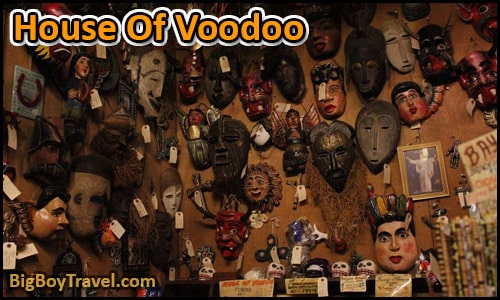
About Marie Laveau’s House Of Voodoo : Marie Laveau’s House Of Voodoo is a really cool Voodoo themed tourist shop. The House of Voodoo offers a wide variety of items to help in both learning about and practicing both the spiritual and religious ceremonies of Voodoo. Tribal masks and statues from around the world symbolize man’s connection with the spirit and earth. Talismans and charms directed towards all different things you many want from the spirits from health, to wealth, and much more. They also have Mojo Bags, Voodoo Dolls, Spell Kits, and a fortune teller and palm reader on-site. They typically do not allow photos inside.
Hours : Sunday-Thursday 10am-11:30pm; Friday-Saturday 10am-1:30pm. Cost : Free to enter. Museum Website : ( HERE ).
20. Tropical Isle Bar ( 721 Bourbon Street ):
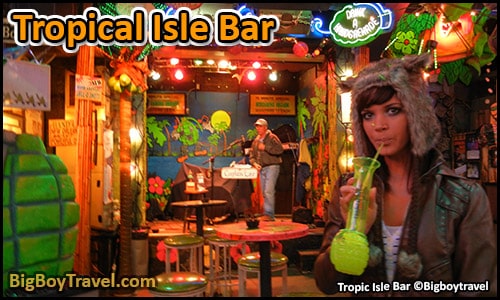
About Tropical Isle : Although the Original Tropical Isle is down the street ( 600 Bourbon Street ), this Tropical Isle location is one of the most fun bars on this free French Quarter walking tour. They have live music, a really funky interior, great balcony, and are known for their over-the-top signature drinks the Shark Attack and Hand Grenade . The fun Shark Attack is truly that as each one comes with a rubber shark the attacks your drink as warning lights flash the bar leaving a pool of blood ( grenadine ).
Make sure to see how high you can blow on the bar’s breathalyzer machine contest . If competition is truly your thing, the urinals in the bath also have the wizinator game where you can race your neighbor. Right next to the Tropic Isle is the Funky Pirate Bar , which has the same owners and has a great assortment of late night live Blues music.
Bar Hours : Daily Noon-2am ( 3:30am on Friday & Saturdays ). Live Music Schedule : Tropical Isle typically has live music Monday-Thursday 5pm-1:30am and Friday-Sunday 1pm-close; next door at the Funky Pirate their Jazz & Blues music runs Monday-Wednesday 8pm-close and Thursday-Sunday 4pm-Close with Saturdays sometimes starting at 1pm; the original Tropic Isle at 600 Bourbon has music daily 1pm-Close. Bar Website : ( HERE ).
21. Le Pretre Mansion ( 716 Dauphine Street ):
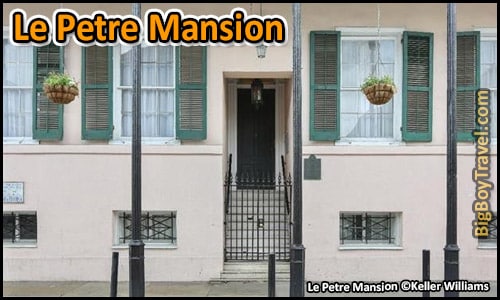
About Le Pretre Mansion : The creepy Le Pretre Mansion is rumored to be haunted after the gruesome events that took place in the 1800s. Built in 1836, the mansion was later bought by plantation owner Jean Baptist Le Pretre as an urban getaway during the Winter months. In 1879 Le Pretre decided to rent his mansion out to the brother of the Sultan of Turkey . Along with the Sultan’s brother came eunuch guards and 17 harem girls. The home quickly became the frequent scene of large parties and orgies.
After 3 years of frequent parties the house went silent one night in 1882 and an old lady passing by saw a river of blood pouring down into the street. When the authorities burst in they found 37 mutilated bodies, but it took 3 days to find the body of the Sultan’s brother who was buried alive in the courtyard. There had been no screams and the murders are still somewhat of an unsolved mystery. To this day, however, many locals claim to have heard screams by the home and have seen haunting shadows in the windows.
22. Cat’s Meow Karaoke Bar ( 701 Bourbon Street ):

About The Cat’s Meow : The highly rated Cat’s Meow has way more of a lively party atmosphere then your normal Karaoke Bar and is very fun even if you don’t like to sing. Many famous musicians have enjoyed some of the nightlife at the Cat’s Meow ranging from soul singer Seal to country musicians Brooks and Dunn, comedian/songwriter “Weird Al” Yankovic, the Smashing Pumpkins, Depeche Mode, and N’Sync have all sang here. Other celebrities from software mogul Bill Gates of Microsoft, actors Tori Spelling, Mario Lopez, Julie and Doria of Playboy’s Night Calls, and adult film star Stormy Daniels have stopped into the Cat’s Meow to sing.
Aside from the more famous people that have visited Cats Meow, several national television shows shot on-site broadcasts from the club. The festive atmosphere of the Cats Meow has provided wonderful backdrop and ambiance for such popular TV programs like The Regis and Kelly Show, MTV’s Road Rules and The Grind. We love the Bar’s 3-for-1 happy hour and of course the fact that all your friends back home can watch you sing your lungs out on the live webcam posted on their website. If your more in the mood for some great live music, consider Krazy Korner ( website ) which lies kiddy corner from Cat’s Meow. This compact corner bar can be a really fun place to get your Jazz and Blues fix.
Cat’s Meow Hours : Daily until late. Bar Website : ( HERE ).
23. Preservation Hall ( 726 Saint Peter Street ):
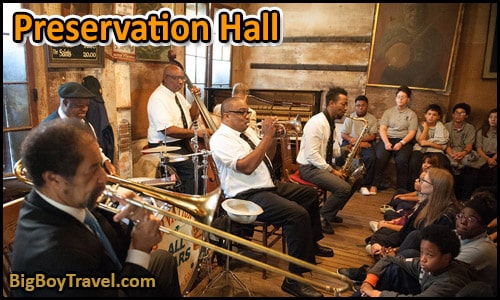
About Preservation Hall : Today’s Preservation Hall was opened in 1961 to help protect the traditions of live Jazz music as Rock-n-Roll took over America. The Hall is a popular place to hear traditional New Orleans Jazz at night. It’s a widely popular place with older crowds to hear traditional New Orleans Jazz at night so check their nightly schedule as you pass by. Please note that during the day they are closed, shows starting usually around 8pm, and even when they are open they do not sell alcohol.
Across the Street from the Hall are Yo Mama’s , known for its great burgers, and an old French cottage building housing Reverend Zombies House of Voodoo. The Voodoo shop is not as good as the others from earlier on this French Quarter walking tour, but just outside is where you can join a walking tour by Haunted History Tours ( website ). We highly recommend fitting one of their tours into your stay if you are in New Orleans for a few days which range from ghosts, to cemeteries, and even vampires. Others haunted tours that we like are Lord Chaz ( website ) and the very highly rated Jonathan Weiss Tours ( website ).
Preservation Hall Website : ( HERE ).
24. Pat O’Brien’s Piano Bar ( 718 Saint Peter Street ):
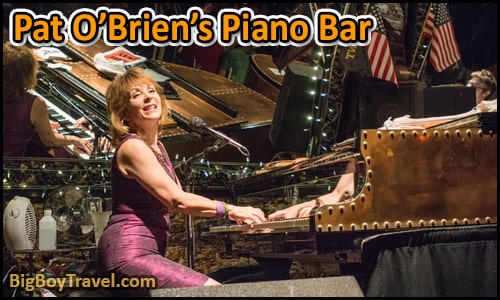
About Pat O’Brien’s Piano Bar : Pat O’Brien’s may be known for its red Hurricane Drinks, Dueling Pianos , and large outdoor patio with flame fountains we also love the bar’s history. In 1791, Maison de Flechier built a private home ( 600 Saint Peter Street ) which later became home to the French Theater Company, then was home to the 1st Grand Opera in America, and later then morphed into a speakeasy . With the lifting of prohibition, Pat O’Brien bought the speakeasy in 1933 and turned it into a full-service bar.
Pat O’Brien’s Bar was so popular for its piano music and drinks that it needed to expand and quickly moved into the current location ( 718 Saint Peter Street ) which was built in 1834. The bar’s popularity hit epic status when Pat O’Brien created the Hurricane Drink in the 1940s which cemented the establishments home forever in the New Orleans drinking scene.
As you enjoy some live dueling pianos, makes sure to notice the crossed muskets from 7 counties and over 500 beer steins that decorate the ceiling of the bar. They also have a large outdoor courtyard with stunning fire fountains to keep you warm after dark. If you happen to be in town with a group and are looking to book an amazing space for your private party, the Briar’s Lounge ( website ) at Pat O’Brien’s is amazing. Modeled after Napolean’s private suite, the entire second floor really lets the 1834 roots of the building shine through.
Pat O’Brien’s Hours : Monday-Thursday Noon-Close; Friday-Sunday 10am-Close. Dueling Piano Music : Often daily during the day but the main times are Monday-Thursday 6pm-Close; Friday-Sunday 2pm-Close. Cup Deposits : Included in the price of your Hurricane drinks is a deposit on your stylish glass which you can keep to bring home ( they can package it ) or turn it in for a refund. Bar Website : ( HERE ).
25. LaBranche House ( 700 Royal Street ):
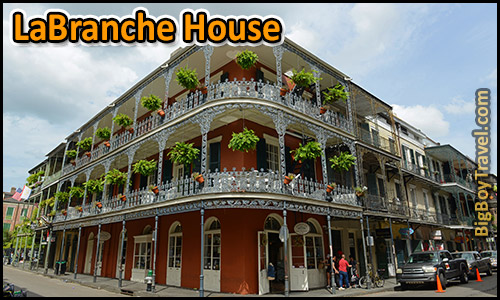
About The LaBranche House : Built in 1835, the large LaBranche House is one of 11 homes the rich sugar planter Jean Baptiste LaBranche built in the French Quarter. With its many levels of detailed cast-iron gilding, the LaBranche House is one of the most photographed buildings in the New Orleans. We especially like taking photos of this large corner lot mansion in December when it’s decorated in holiday lights.
It is important to note, especially among locals, that decorative balconies on the LaBranche House are actually called galleries . Galleries go all the way to the ground with supportive posts while balconies only jut out of the side of a home. Sitting directly across Saint Peter Street from the LaBranche House, you’ll find the Le Monnier Mansion ( 640 Royal Street ). When Le Monnier was built in 1811 it was considered to be a “sky scrapper” of its day even though it was just 3 stories tall at the time.
26. Pirates’ Alley ( 622-698 Pirates’ Alley ):
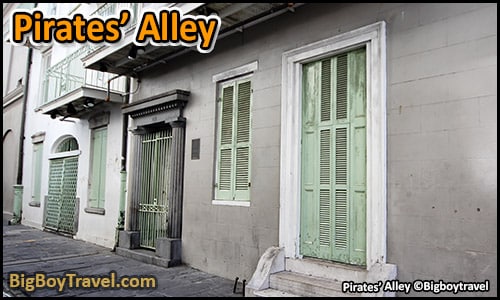
About Pirates’ Alley : Originally called Orleans Alley, the 16 foot wide Pirates’ Alley is steeped in folklore . The tales range from mad scientists to swashbuckling pirates, and although they are mainly fiction, the stories are fun to dream about. In early day New Orleans, the alleyway was more of a shortcut path to get behind the cathedral and wasn’t even paved with cobblestones until 1831, long after pirates left New Orleans. Because the alley was right next to the main public square, Cabildo town hall, and was home to the jail, the local pirates would have likely avoided the path.
In real life, the often foggy alley did house a few famous residents at times including briefly Andrew Jackson ( 616 Pirates Alley ) and author William Faulkner ( 624 Pirates Alley ). Faulkner, the Nobel Prize prize winner author, wrote his first published novel Soldiers’ Pay in 1924 while living in this house. Faulkner House Books ( website ) opened in the home on September 25th, 1990 in honor of the writer’s birthday. Our favorite house is the Creole House which now holds the Pirate Alley Cafe ( 622 Pirates Alley, website ). This corner home started as a French guardhouse and jail in 1728 which was nicknamed the Calabozo during Spanish rule and rebuilt after a series of fires. The Calabozo Jail once held Pierre Laffite, brother of pirate Jean Laffite, who famously escaped from prison here in 1814. The current Creole House replaced the jail in 1837 and with the legends taking hold, the lane’s name was officially changed to Pirate’s Alley in 1964.
Before leaving the Pirate’s Alley, make sure to check out the fenced-in Saint Anthony Garden behind the Saint Louis Cathedral. The beautiful statue of Jesus with his arms raised in the air is illuminated at night to cast a breath-taking shadow silhouette on the back wall of the church. The statue, which was damaged by Hurricane Katrina in 2004, is often called Touchdown Jesus by local football fans.
27. Streetcar Named Desire House ( 632 Saint Peter Street ):
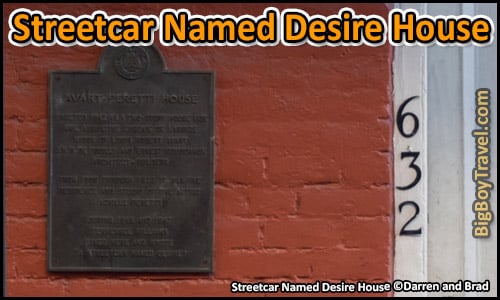
About The Streetcar Named Desire House : If you pop down St. Peter a couple houses to 632 you’ll find the red brick home where Tennessee Williams wrote the book Streetcar Named Desire. The book became not only and instant hit and symbol of New Orleans, but was also turned into a very successful play. The film adaptation of the book from 1951 is a must watch movie before your visit to New Orleans. From time to time you can still she tourists yell “Stella” at the house in the spirit of the play.
Next door to the Streetcar Named Desire House you’ll run into one of our favorite restaurants, The Gumbo Shop ( 630 Saint Peter Street, website ). This great restaurant will help you get your fill of Creole cooking with its mouth-watering Gumbo. Our personal favorite is the chicken and sausage gumbo which is truly amazing and is on our list of the Top Ten Must Eats In New Orleans .
28. Court of Two Sisters ( 613 Royal Street ):
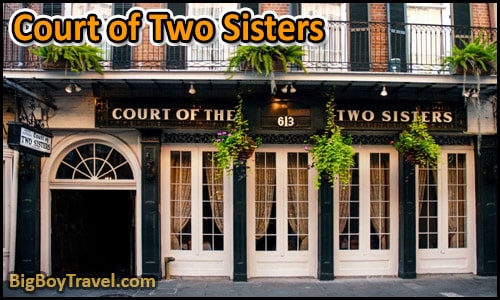
About The Court of Two Sisters : The Court of Two Sisters is a great restaurant to visit if you want some more high end dining in New Orleans. Their award-winning food is served in three different indoor dining areas, plus they have a timeless bar and a breath-taking inner courtyard under a gorgeous canopy of interlaced wisteria tree branches . Make sure to rub wrought irons gates at the main entrance which were blessed by Queen Isabella of Spain for good luck. While the food is gourmet, the atmosphere is still has a very laid back New Orleans feel.
The restaurant’s location also has a storied past to go along with the excellent food. In 1726 Sieur Etienne de Perier, the second French royal governor of colonial Louisiana, was the first to live here. Originally the entire 600 block of Royal Street was originally nicknamed Governors’ Row for all of its powerful residents. At the time this stretch of road was home to 5 governors, 2 State Supreme Court Justices, a future U.S. Supreme Court Justice, and Zachary Taylor who later became the 12th President of the United States lived for a time at 621 Royal Street. Needless to say, if you lived on this block of Royal Street in the mid-1700s you were among some excellent company.
The current building was completed in 1832 and after changing it became a store known as the “The Shop of the Two Sisters” in 1886. The shop was run by two daughters of a local aristocratic Creole family who became famous throughout the Gay 90s for there custom Mardi Gras dresses and perfumes imported from Paris. After becoming a restaurant in 1968, The Court of Two Sisters became famous for their daily Jazz Brunch which takes place in the inner courtyard. It’s said that the legendary pirate Jean Lafitte once killed three men in three separate duels one night under a willow tree that once stood in the courtyard.
Jazz Brunch : The 3 course Jazz Brunch is excellent and starts around $50 per person. Website : ( HERE ).
29. Merieult House Collection ( 533 Royal Street ):
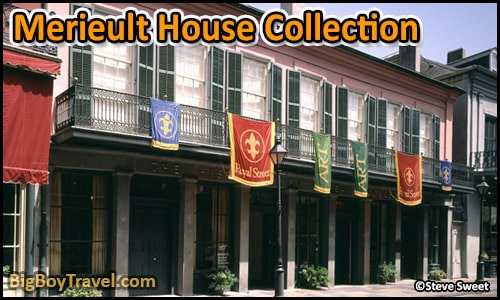
About The Merieult House : This block of Royal Street was originally owned by the French government who built a workmen’s barracks and the king’s forge here in 1720. Those buildings, along with most of the neighborhood was lost in the Great Fire of 1788 which destroyed 856 of the 1,100 structures in New Orleans. This epic blaze on Good Friday ( March 21, 1788 ) wiped out a lot of the original French architecture in the city as the recovery development was done under Spanish governance.
The destruction from the fire made way for the Merieult House which was built in 1792 by the prosperous merchant Jean Merieult. It is said that Merieult’s wife was so beautiful that Napoleon wanted to buy some of her hair as a wig for the Sultan of Turkey. Six years after the first huge fire the Great Fire of 1794 hit taking out 212 structures over 18 nearby blocks, but luckily the Merieult House barely survived it.
Today the Merieult House is the centerpiece of a collection of connected homes you can tour together to get a glimpse of life in the early-1800s. The adjacent buildings you get to visit on the block as part of the tour include neighboring homes, former warehouses of Jean Merieult, the Counting House, and the Williams House. The fine details and furnishing may not be as impressive as some of the other homes on this free French Quarter walking tour, but the guides are great and you get to cover a lot of buildings in a relatively quick visit.
Hours : Tuesday-Saturday 9:30am-4:30pm; Sunday 10:30am-4:30pm; Closed Mondays. Cost : The 1st-floor gallery is Free, Guided Tours are $5. Guided Tours : 45-minute tours of the 11 galleries on the second floor provide a comprehensive look at the settlement and development of Louisiana from the early 18th century to the present. Tour Times : Tuesday–Saturday 10am, 11am, 2pm, 3pm and Sunday 11am, 2pm, 3pm. Museum Website : ( HERE ).
30. One Eyed Jacks ( 615 Toulouse Street ):
About One Eyed Jacks : Expect a lot of live music ranging from jazz, funk, hip hop, to rock as well as touring comedy acts and alternative shows at One Eyed Jacks. The most famous show is the sexy Burlesque show called Fleur de Tease ( website ) which takes place daily at 8pm & 10pm. Fleur de Tease is a premiere Variety Burlesque Revue. This modern twist on a classic vaudeville show has something to please and tease every audience member. Magicians, fire eaters, comedians, aerialists and of course beautiful burlesque dancers all make up the core members of the troupe. Special guest artists such as sword swallowers, singers, and other circus acts make each show a unique and different experience so no two programs are ever the same.
Not far from One Eyed Jacks is the former home of Army Treasurer Don Vincente Jose Nuñez ( 619 Chartres Street ) where the Great Fire of 1788 started.
Burlesque Show Cost : For the Fleur de Tease general admission is $15 and reserved seating is $20. Other Shows vary. Show Times : Fleur de Tease is daily at 8 & 10pm. Other traveling shows vary. Bar Website : ( HERE ).
31. Napoleon House ( 500 Chartres Street ):
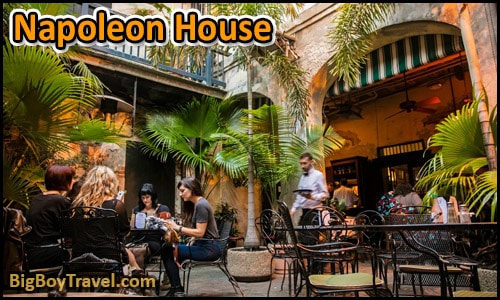
About The Napoleon House : House built for New Orleans mayor Nicholas Girod in 1812 who offered it to Napoleon in 1921 as a refugee during his exile from France. Unfortunately, Napoleon died of poisoning the same year and never made it New Orleans. Luckily the home was turned into a restaurant in 1914 and still bursts at the seams with charm. Seriously go here and eat or at least stop by for a drink, the old vibe is awesome.
Hours : Sunday-Thursday 11am-10pm; Friday & Saturday 11am-11pm. Website : ( HERE ).
32. Louisiana State Supreme Court ( 400 Royal Street ):
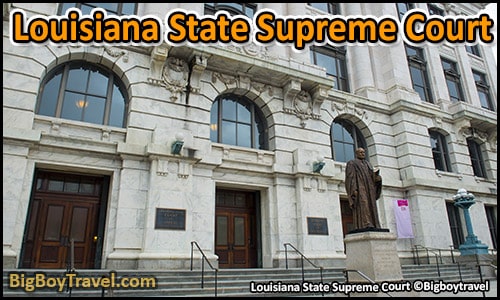
About The Louisiana State Supreme Court : Built in 1908, the huge Louisiana State Supreme Court building looks almost like a marble palace and takes up an entire city block. While the court was established in 1813, the new building was required when it moved from the Cabildo building in Jackson Square. Nearby is a delightful yellow mansion which used to be the Louisiana State Bank. The is not really a whole lot more to say about either building’s history, but every time we visit we end up being impressed and taking a lot of photos.
Website : ( HERE ).
33. Antonie’s Annex ( 513 Royal Street ):
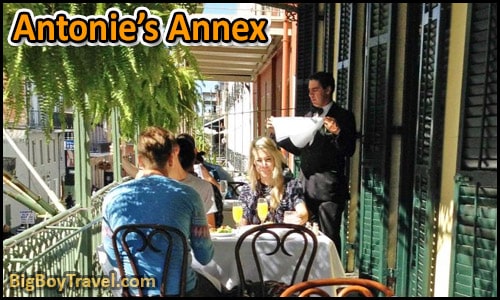
About Antonie’s Annex : After the restaurant opened in 1840, Antonie’s Annex quickly became the place for New Orleans locals to get their Bourbon Whiskey and Black Coffee drink called Café Brûlot . Variations of the drink were vast and in the 1890s the owner Jules Alciatore created a flaming concoction of coffee, brandy, and spices he called Café Brûlot Diabolique . This new concoction became a huge hit and even more popular during Prohibition as a great way to disguise alcohol.
If it is your first time to New Orleans, visiting the famous Antonie’s can be a little confusing as there 14 dining areas all with unique history and charm inside the massive complex . While many people all the entire place Antonie’s Annex, the Annex is actually the more casual cafe and deli area around the corner of the block ( 513 Royal Street ) with excellent coffee, sandwiches, pastries, and take away items. We love the Annex, but it can also be nice to visit the unique dining rooms of the more fancy sit down Antonie’s Restaurant ( 713 Saint Louis Street ) which also has its own bar called Hermes. The sit-down restaurant does have more limits hours of operation and you definitely want to make a reservation if you want to go for dinner.
Annex Cafe Hours : Daily 8am-7pm. Restaurant Hours : Lunch Monday-Saturday 11:30am-2pm; Dinner Monday-Saturday 5:30-9pm; Jazz Brunch Sundays 11am-2pm. Website : ( HERE ).
34. Hermann-Grima House ( 820 Saint Louis Street ):
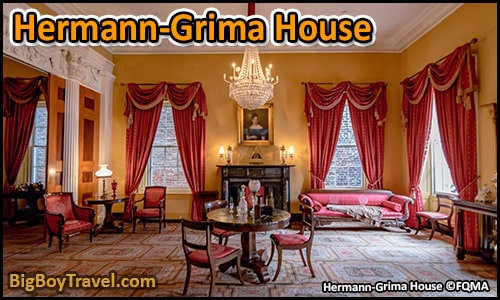
About The Hermann-Grima House : While the Gallier House from earlier on this free French Quarter walking tour focused on middle-class living, it is the wealthy on showcase at the Hermann-Grima House. A walk through the meticulously restored Hermann-Grima House and gardens allow you to peak back into this the Golden Age of New Orleans history. It was built in 1831, by a German Jewish immigrant, Samuel Hermann, who amassed his fortune in the cotton market. This handsome Federal mansion with its courtyard boasts the only horse stable and functional 1830s outdoor kitchen in the French Quarter. The outdoor hearth kitchen, with its view of the antique roses, citrus and parterre gardens, provides a dynamic experience for our visitors.
As a museum, the home celebrates artistic contributions and building trades of the Free People of Color and enslaved persons in New Orleans, without who, the Hermann-Grima House would not stand today. Visitors are also fascinated to learn that Hermann originally purchased the property from a Free Woman of Color . The interior of the home was also used as Madame LaLaurie Mansion in the TV show American Horror Story . The same owners of the Hermann-Girma House also own the Gallier House which we was earlier in this free French Quarter walking tour.
Hours & Tours : Monday, Tuesday, Thursday, Friday hourly tours 10am-3pm; Wednesday tours by appointment; Saturday hourly tours 12pm-4pm. Cost : Adults $12; Children $10. Add the Gallier House ( Stop 13 ) for $8. Museum Website : ( HERE ).
35. Larry Flynt’s Barely Legal Strip Club ( 423 Bourbon Street ):
About Larry Flynt’s Barely Legal Strip Club : Larry Flynt’s is one of the many strip, lap dance, and cabaret clubs that pepper the 200-400 blocks of Bourbon Street. The presence of these clubs may feel trashy or grimy to some, but they are isolated and add to the personality of the care-free French Quarter. While strip clubs aren’t really our thing, walking by them is still a unique tourist experience somewhat similar to the Red Light District in Amsterdam. Do remember that you are in the Big Easy so try not to be uptight about the clubs being there.
Club Website : ( HERE ).
36. Old Absinthe House ( 240 Bourbon Street ):
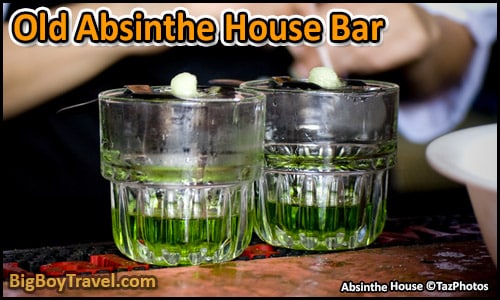
About The Old Absinthe House : Shortly after the building opened as a coffee house in 1807, the owners came up with a new drink using the wormwood herb-based alcohol Absinthe they called the Absinthe House Frappe . This narcotic-like drink became so popular that the owners eventually decided to change the coffee house’s name to the Old Absinthe House. The name was later expanded to Jean Lafitte’s Old Absinthe House, as this is the place where pirate Jean Lafitte and General Andrew Jackson ended up planning the Battle of New Orleans .
Lafitte and Jackson haven’t been the only celebrities to grace the bar as their bartenders tell us that Mark Twain, Voodoo Queen Marie Laveau, Oscar Wilde, P.T. Barnum, General Lee, and Edgar Allen Poe also came to get their Absinthe on. As you can see by the business cards, postcards, sports jerseys, football helmets, and celebrity photos that plaster the walls of the bar, people are still coming here from all corners of the world.
When wormwood-based Absinthe became illegal in 1912 for being “hallucinogenic”, the owner switched to a Herbsaint-based Absinthe to keep the business running strong. Thanks to a change in the law they were once again able to go back to using Wormwood in 2007. One of the coolest things inside is the original copper-colored bar which had been removed for its own protection during Prohibition and was finally returned in 2004. The photo we used of the Old Absinthe House is from a postcard dated 1910.
Attached to the Old Absinthe House the bar’s owner Tony’s Moran also runs called Tony Moran’s Restaurant ( website ) which is renown for its Crawfish. Overall we’ve found Moran’s to be a little pricey for what you actually get and you are better off going down a block to Iberville Street where you’ll find Felix’s Restaurant ( website ) & Acme Oyster Bar ( website ). Both of their menus are great, cover a wide range of food including Oysters and Crawfish, and are much more affordable than Tony Moran’s. Our favorite New Orleans dishes are Po-boy Sandwiches and the Fried Seafood Platter so make sure to read more about our Top Ten Must Eats In New Orleans .
Bar Website : ( HERE ).
37. The Carousel Bar ( 214 Royal Street ):
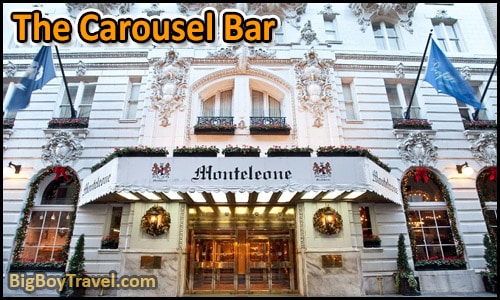
About The Carousel Bar : With great views overlooking Royal Street, The Carousel Bar in the Hotel Monteleone ( website ) is the only bar in New Orleans that revolves around the room. The focal point of the bar is the rotating the 25-seat carousel bar , which was originally installed in 1949. The large embellished carousel turns on 2,000 large steel rollers, pulled by a chain powered with a one-quarter horsepower motor creating a very smooth ride. While the bar always rotates at the same speed, visitors who have drink at the bar for a while often claim that the bartender has turned up the motor’s speed. The bar was renovated in 1992 when the current carousel top was added. Fiber optics were also installed in the ceiling to create unique stars in the night sky and even one special shooting star was created to cross the room at regular intervals.
In the early days of the Carousel Bar, the hotel was the home to the famous Swan Room , a nightclub where celebrities such as Liberace performed . It wasn’t unusual for the performers to join their friends for a nightcap after their shows. William Faulkner, Tennessee Williams, Truman Capote, and Winston Grooms ( Forrest Gump ) are among the famous authors who have enjoyed drinks at the Carousel Bar. Today, the Carousel still attracts celebrities, including some recent sightings – Michael Jordan, Dennis Quaid, Greg Allman, and Sally Struthers.
In addition to the rotating bar, the adjoining room features quiet booths and tables where live entertainment is offered nightly at the piano. If you arrive at just the right time during the cocktail hour you can enjoy complimentary hors-d’oeuvres from the famous Monteleone kitchen. Our favorite original drinks at the Carousel are French flared Vieux Carre Cocktail and the Caribbean inspired Goody .
Bar Hours : Daily 11am-2am, get there early to avoid a long wait for your turn on the 25-seat carousel. Bar Website : ( HERE ).
Other Sights Near The French Quarter Walking Tour:
38. house of the blues ( 225 decatur street ):.
About The House Of The Blues : WEven with the heavy Jazz influence on New Orleans, you can’t come to the Big Easy without getting your fix of blues music and the House of the Blues gets some of the biggest names. Even if you can’t make one of their daily performances, they have a unique vibe to grab a drink and the colorful entrance makes for great photo opportunities. By far our favorite thing at the House of the Blues has an amazing Gospel Choir Brunch every Sunday morning which cost $40.
Bar Hours : Daily 11:30am-Close. Show Cost : Daily performances/events costs vary, but they are always open for dining and drinks. Bar Website : ( HERE ).
39. Saint Louis Cemetery #1( ( 425 Basin Street ):
About Saint Louis Cemetery #1 : New Orleans’ oldest cemetery from 1789 is a spooky one indeed with tales of Bloody Mary and the tomb of Voodoo Queen Marie Laveau . The blocks around the St Louis Cemetery #1 can be very shady as the neighbor is part of the often dangerous Storyville Projects. Only go during the day with a tour group. We like the tour from Save Our Cemeteries ( website ) the most which leaves Daily at 10am plus Fridays & Saturdays having a second tour at 1pm. The tour is run amazing, costs $20 a person and lasts 1 hour. Other tour companies charge from $30 to $50 per person for pretty much the same tour, however, the money that Save Our Cemeteries makes goes toward the restoration of the tombs.
Featured Article

Sign Up For Our Newsletter For Free Travel Tips
Email Address *
Disclaimer: Information on this page and in our walking tours were deemed accurate when published, however, details such as opening hours, rates, transportation, visa requirements, and safety can change without notice. Please check with any destinations directly before traveling.

Jackson Square
In the heart of New Orleans' French Quarter you'll find Jackson Square - which has long been the center of activity in the French Quarter. If you're visiting New Orleans, make sure you check out Jackson Square
Visiting Jackson Square
Walking down Decatur Street from Jax Brewery, following along the MIssissippi River’s banks, you can hear the sound of the calliope playing a familiar tune from the Steamboat Natchez and its churning paddles. The sound of chatter from tourists talking about what they want to do, see, or taste next is a reminder why this city is so special.
A view from the steep steps of Washington Artillery Park, overlooking Jackson Square across the street, features a two piece jazz ensemble playing “When the Saints Go Marching In.” With the iconic green and white striped awnings of Cafe Du Monde to the right, you can smell fresh Cafe au Lait and hot, powdered sugar-coated beignets coming from the wrought iron tables of happy tourists. The Royal Carriage Company has mule and carriages lined up in front of Jackson Square awaiting guests who want a one-of-a-kind tour of the city. The click-clack of the mule hooves match the beat of the live jazz music and create a rhythm found only here in the heart of the French Quarter. You can watch the local artists who display their original works on the fence of Jackson Square wrapping their paintings up for visitors to take home as colorful momentos of their time spent in this magical city.
St. Ann Street along the right side of Jackson Square, and St. Peter Street along the left, host the Pontalba apartments - the oldest continuously-rented apartments in the United States. Downstairs, the buildings house unique shops and restaurants. Visitors to the city pass by these buildings completely unaware of their past. From here you can see the facade of Muriel’s Restaurant, where you can dine with their ghost host Jourdan, and visit the seance lounge bar upstairs.
Making your way across Decatur street, passing through the heavy, black, iron gates and into the square itself, you can find a bench with a charming view of St. Louis Cathedral near the fountain and Andrew Jackson’s statue, while the bells of the Cathedral chime, reminding you to slow down and breathe. Tourists and locals alike are scattered all around the square, taking pictures in front of the statue, relaxing on the iron benches, sitting on the soft grass, and passing through on the sidewalks to get to destinations elsewhere in the French Quarter.
The stark white facade of the Cathedral, the Cabildo and Presbytére to either side of it, and the jetting palm trees and greenery in front, paint a lovely picture only seen in this favorite location in the French Quarter. Street musicians play a lively tune; couples, friends, and travelers dance on the cobblestone in front of the cathedral, laughing and swaying to the music of the city. Street performers have the full attention of vacationers on the other side of Jackson Square, sharing sensational magic tricks and impressive dance routines, and engaging their audiences with interactive presentations. Listening closely, you can hear the soft voice of the nearest fortune teller expressing concern for her patron’s future, and the sound of birds bathing and splashing in the water of the fountain. The aroma of azaleas surrounding the square with their bright pink blooms is almost overwhelming, but adds to the gumbo of sensations you can only experience by sitting in the middle of Jackson Square, the French Quarters’ most famous and notable site.
What is Jackson Square?
New Orleans’ most recognized historic landmark, Jackson Square, is a picturesque park in the heart of the French Quarter about the size of a city block. Playing a pivotal role in New Orleans history, it is the site of the Louisiana Purchase and designed after the 17th Century Place des Vosges in Paris, France. At its center and erected in 1856, lies the statue of Andrew Jackson, 7th President of the United States and hero of the Battle of New Orleans. First known as Place d’Armes, Jackson Square was renamed for the city’s victorious General following the infamous 1815 battle. During the eighteenth and nineteenth centuries, Place d’Armes set the scene for graphic public executions where criminals and slaves were hanged and left for dead.
The 1803 ceremonial transfer of power from Spain to France and then from France to the United States, is symbolized by the flagpole in the center of Jackson Square. Micaela Almonester, Baroness de Pontalba, designed the Parisian-style landscaping you see today and built the Pontalba apartment buildings on either side of the square.
Jackson Square overlooks the mighty Mississippi River via Decatur Street and Washington Artillery Park. Perhaps the most famous building in all of New Orleans is located on Jackson Square, St. Louis Cathedral. The Cabildo (showcasing rare artifacts of New Orleans and Louisiana State history) and The Presbytère (displaying two permanent displays; the Mardi Gras exhibit and Hurricane Katrina exhibit) flank the Catholic Cathedral and are home to the Louisiana State Museum.
Jackson Square Things To Do
No trip to New Orleans is complete without a visit to the city’s most famous landmarks and museums: St. Louis Cathedral, The Cabildo and Presbytére, Le Petit Theatre, Washington Artillery Park, 1850 House, Royal Carriages, Jax Brewery, unique shops, local artists and performers, and fine dining can all be found on and around Jackson Square, the number one destination for New Orleans visitors.
1850 House: 523 St. Ann St. Open Tuesdays-Sundays 10am-430pm
Take a step back in time 150 years with a glimpse into upper-middle-class life in New Orleans. The 1850 House is part of the Louisiana State Museum.
The Cabildo: 701 Chartres St. Open Tuesdays-Sundays 10am-430pm
This formal Spanish Colonial building is located to the left of St. Louis Cathedral and houses a rare artifacts collection and compilation of New Orleans history only found at the Louisiana State Museum.
Jax Brewery: 600 Decatur St. Open Sunday-Thursday 10am-7pm, Fri-Sat 10am-8pm
Once the brewing and bottling house of Jax Beer from 1891 to the 1970s, Jax Brewery is now home to an array of unique New Orleans shops and restaurants, as well as easy access to the Mississippi River walk and the Steamboat Natchez.
Le Petit Theatre: 616 St. Peter St.
Le Petit Théâtre Du Vieux Carré is New Orleans’ most historic playhouse. The current address has been home to Le Petit Theatre since 1922 where it has entertained thousands of patrons and continues the tradition today.
The Presbytére: 751 Chartres St. Open Tuesdays-Sundays 10am-430pm
Two permanent exhibits are displayed in the Presbytére as part of the Louisiana State Museum; an extensive Mardi Gras collection and historical timeline, as well as the Hurricane Katrina memorial exhibit.
Royal Carriages: 700 Decatur St.
Since 1941, Royal Carriages has been providing draft mules and carriages for their unique guided tours of the French Quarter.
St. Louis Cathedral: 615 Pere Antoine Alley Open daily from 830am-4pm
The most recognized landmark in all of New Orleans, the St. Louis Cathedral, is open daily for mass and tours. New Orleanians have been worshipping on these venerable grounds since 1727.
Washington Artillery Park: 768 Decatur St. Open 24 hours
The steep steps leading up to Washington Artillery Park from Decatur St. are worth the climb for the views of Jackson Square and the Mississippi Riverfront. It has a mounted Civil War cannon and is home of New Orleans’ French Quarter Christmas tree during the holidays.
Jackson Square Restaurants and Eats
If there’s one thing New Orleans is best known for, it’s exquisite Creole Cuisine: Muriel’s Jackson Square, Cafe du Monde, Tableau, The Corner Oyster House, Monty’s on the Square, Stanley Restaurant, Sylvain, Gumbo Shop, Spitfire Coffee, Tujague’s, and Doris Metropolitan New Orleans are just a handful of the eats and drinks at, around, and near Jackson Square.
- Cafe du Monde: 800 Decatur St. Open 24 hours
- The Corner Oyster House: 500 St. Peter Open daily 9am-midnight
- Doris Metropolitan New Orleans: 620 Chartres St. Open daily for dinner 530pm-1030pm
- Gumbo Shop: 630 St. Peter Open daily 11am-10pm
- Monty’s on the Square: 801 Decatur St. Open daily 8am-7pm
- Muriel’s Jackson Square: 801 Chartres St. Open daily 1130am-10pm
- Spitfire Coffee: 627 St. Peter Open daily 8am-8pm
- Stanley Restaurant: 547 St. Ann St. Open daily 7am-7pm
- Sylvain: 625 Chartres St. Open M-Th 530pm-11pm, F-Sa 530pm-12am, Sun 530pm-10pm
- Tableau: 616 St. Peter Open daily 11am-10pm
- Tujague’s: 823 Decatur St. Open daily for lunch 11am-230pm and dinner 5pm-9pm
Jackson Square Arts, Music, and Festivals
Whether you’re looking for unique, one-of-a-kind local art, colorful galleries, fortune telling, street performers, live jazz musicians, the French Quarter Fest, Caroling in Jackson Square, New Year’s Rockin’ Eve, or a beautiful place to get hitched in New Orleans, Jackson Square is the place to be.
The open-air artist colony displayed on the iron fence of the square has been thriving for over 50 years, some of the artists working and selling have been showcasing their wares through generations. The Rodrigue Studio is located behind Jackson Square and is a must-see for any true New Orleans lover.
A free music and cultural festival, French Quarter Fest takes place annually in April. While it appears across the whole French Quarter, Jackson Square is the heartbeat of the fest as well as the city.
Jackson Square Location and Hours of Operation
Following Decatur Street between Jax Brewery and the iconic French Market, you can’t miss the three steeples of St. Louis Cathedral and the black, iron gates of Jackson Square. Across the street from the original Cafe du Monde Coffee Stand and Washington Artillery Park, the square overlooks the Mississippi Riverfront. This historic landmark of New Orleans can’t and shouldn’t be missed! So grab a bench in the middle of Jackson Square, rest your weary feet from wandering the French Quarter, take a look around at all of the history at your fingertips, break out your camera, and capture images of beloved New Orleans that you will treasure for years to come!
Jackson Square is located at 700 Decatur St, New Orleans. Open 7 days a week, 8am-6pm in the winter months, 8am-7pm during Daylight Savings Time.
Where is Jackson Square?
Do you want to learn more about New Orleans?
Many people coming to New Orleans are interested in taking a tour. Luckily for you, Gallivanter offers the top-rated tour in New Orleans. Check them out.

- Restaurants
- Creole & Cajun Food
- Popular Restaurant Recipes
- Favorite Attractions
- Swamp Tours
- Cemetery Tours
- Ghost Tours
- Plantation Tours
- Carriage Tours
- Jackson Square
- Outdoor Adventures
- Itineraries
- Neighborhoods
- Transportation
- Family Guides
- New Orleans Cemeteries
- Cajuns & Creoles
- Shop in New Orleans!
- Souvenirs & Mardi Gras Beads
- New Orleans Art
- New Orleans Food
- French Quarter Shopping
- Tax Free Shopping
- Moving to New Orleans
- Book Your Stay!
- Adults: 1 2 3 4
- Rooms: 1 2 3 4
- An Afternoon in Jackson Square
- Jackson Square in the French Quarter
- St. Louis Cathedral
- Jackson Square Artist Community
- Jackson Square Artists
Contributed by Nick Cognevich, Jr.
NEW ORLEANS, LOUISIANA--On a recent lazy Sunday afternoon, I decided to play tourist in New Orleans. I didn't know it at the time, but my automobile has a mind of its own. Both my car and I ended up in the famous New Orleans French Quarter.
I left it in a local French Quarter parking lot and let my nose follow the sweet smells of New Orleans cooking. Those smells were so delicious that I had trouble choosing between fine Creole cuisine and a cafe au lait with beignets.
I decided the Creole dishes could wait while I had an order of beignets and cafe au lait. Beignets are a light square donut that puffs up when fried. Served piping hot and three to a plate, they are mounded with powdered sugar, and are always served fresh. Cafe au lait is 50% coffee (normally chicory coffee) mixed with 50% warm milk, and served hot.
While I waited, a two-piece band started playing for the restaurant's patrons, and everyone in the cafe enjoyed it. The group was one of the many live-in-the-street bands that travel the area entertaining visitors during the weekends.
Having finished my coffee, my next stop was the Moon Walk to get a view of the Mississippi River. With long ramps leading up to its promenade, the Moon Walk is accessible to wheelchair tourists. At the top, I could see many ships traveling the Mississippi River. With the river to my back, I faced Jackson Square, the St. Louis Cathedral, and the Pontalba Buildings. I could also see many other activities around the square.
Moving away from the Moon Walk, I proceeded to the entrance of Jackson Square. In front of the Square, you'll find many mule-drawn carriages to take you on a 30-minute tour of the French Quarter. I couldn't get over the individuality of these carriage animals; each mule wore a straw hat on its head, giving it a personality all its own.
From there, I walked down to St. Ann Street. Here, I saw the Lower Pontalba Buildings, the 1850 House, and many other small shops. The 1850 House is currently closed for renovation, but is typical of an antebellum rowhouse in New Orleans during the 1840s-50s. You are able to see period artifacts and furniture that reflect New Orleans' most prosperous era.
From St. Ann Street, I turned the corner onto Chartres Street. On this side of Jackson Square are the St. Louis Cathedral, the Presbytere, and the Cabildo. The St. Louis Cathedral is home to the Archbishop of New Orleans. Its history dates back to 1727, with tours available daily. The Presbytere was originally used by the New Orleans Clergy as its quarters. The Cabildo, built by the Spanish, was used as one of the city's government buildings. The Presbytere and the Cabildo are now part of the Louisiana State Museum and are open daily to visitors.
On this trip, I decided to tour the Presbytere, and paid the entrance fee of $6. During my self-guided tour, I saw large working models of wooden sailing ships, a Zachary Taylor exhibit, a Baroness Pontalba exhibit, antique furniture, busts of famous Louisianians, and a collection of formal clothes from the 1890s to the present. Outside of the museum, I saw an original cannon used in the Battle of New Orleans and a miniature 2-person submarine, dating from the Civil War, that was found locally.
From the Presbytere, I entered Jackson Square. There I saw the famous statue of General Andrew Jackson on his horse, tipping his hat. From the park, I had the pleasure of seeing a wedding party get into horse-drawn carriages in front of the St. Louis Cathedral.
In walking outside the square's iron fence, I saw a children's band performing, children tap-dancing, artists, concession vendors, jazz combos and mimes, among other sights!
Well, three hours is plenty of time to explore Jackson Square and have fun doing it. I had so much fun playing tourist, and I'm looking forward to my next sightseeing adventure in Louisiana.
Have a great time on your visit to Louisiana! - Nick
- Things To do
- Visitor Information
- History & Culture
- Bring New Orleans Home
- About This Site
- Quick Links
- Ask a Local
- Privacy Policy
- © 1999-2024 Experience New Orleans
Sign up for our mailing list to receive information on the latest New Orleans news, events, and attractions!

Jackson Square

Price & Hours
- Facilities 2.0
- Atmosphere 5.0
Jackson Square is a National Historical Landmark in the center of the French Quarter tucked away on Decatur Street between the Jax Brewery shopping mall and the French Market. Spread across more than 2 acres, the square welcomes more than 2 million visitors yearly. The square's name is inspired by the bronze statue of Andrew Jackson that stands at the center.
The square has plenty of fun things for travelers to do, including top attractions like the Cabildo and the St. Louis Cathedral . It also serves as an open-air market space for vendors and artists to share and sell their works. After shopping, enjoy a café au lait and a beignet at the world-famous Café du Monde , which is located less than a 5-minute walk east of the square.
Past visitors say the square is a peaceful place to spend an hour or two, but caution that it can get crowded at times.
The No. 5 and No. 55 buses make stops along the corridor, along with the Riverfront streetcar. For more information about the square's history, visit the City of New Orleans website .
Popular Tours

Steamboat Natchez Evening Jazz Cruise with Dinner Option
(5553 reviews)
from $ 55.00

New Orleans Airboat Ride
(3754 reviews)
from $ 59.00

New Orleans Steamboat Natchez Jazz Cruise
(3801 reviews)
from $ 42.00
More Best Things To Do in New Orleans

#1 French Quarter
If you want to experience New Orleans properly, it's best to begin your tour here. Recent visitors said the neighborhood is lively, with lots to do and see and offers a one-of-a-kind experience. The neighborhood, also known as Vieux Carré , is the heart and soul of this city, and it's also a National Historic Landmark. As the site of the original New Orleans colony (established by the French in 1718), the French Quarter has held on to its heritage, complete with street names that are still listed in French. Wander the narrow cobblestone streets to find such attractions as Jackson Square , Faulkner House Books and the Cabildo . While you're strolling, pay attention to the neighborhood's architecture: balconies are designed with baroque ironwork and hanging plants, while leafy courtyards are filled with bubbling fountains. The scene is definitely charming, but it can also be expensive if you choose to stay at any of the French Quarter's hotels .
Undoubtedly, the French Quarter's main draw is Bourbon Street – New Orleans' infamous party hub. You'll find this street laden with performers and fortune tellers as well as rowdy bars. Although a trip to New Orleans isn't really complete without strolling down Bourbon Street, keep in mind that boisterous evenings on Bourbon are best appreciated by adult travelers. If you're tempted to hang your hat on Bourbon Street, don't. While it's fun to be at the center of the action, there's really no escaping the late-night noise.
Explore More of New Orleans

Things To Do

Best Hotels

You might also like

# 14 in Best Places to Visit in Texas

Baton Rouge

Gulf Shores
# 1 in Best Alabama Beaches
If you make a purchase from our site, we may earn a commission. This does not affect the quality or independence of our editorial content.
Recommended
The 28 Best Water Parks in the U.S. for 2024
Holly Johnson|Timothy J. Forster May 8, 2024

The 18 Best Napa Valley Wineries to Visit in 2024
Lyn Mettler|Sharael Kolberg April 23, 2024

The 25 Best Beaches on the East Coast for 2024
Timothy J. Forster|Sharael Kolberg April 19, 2024

The 50 Best Hotels in the USA 2024
Christina Maggitas February 6, 2024

The 32 Most Famous Landmarks in the World
Gwen Pratesi|Timothy J. Forster February 1, 2024

9 Top All-Inclusive Resorts in Florida for 2024
Gwen Pratesi|Amanda Norcross January 5, 2024

24 Top All-Inclusive Resorts in the U.S. for 2024
Erin Evans January 4, 2024

26 Top Adults-Only All-Inclusive Resorts for 2024
Zach Watson December 28, 2023

Solo Vacations: The 36 Best Places to Travel Alone in 2024
Lyn Mettler|Erin Vasta December 22, 2023

26 Cheap Beach Vacations for Travelers on a Budget
Kyle McCarthy|Sharael Kolberg December 4, 2023

- Cashless Ticketing. All Major Credit Cards Accepted.
- Toll Free: 800-362-1811
- 504-207-6200
- Manage My Booking

- ATTRACTIONS
- Safety Measures
City Sightseeing New Orleans Hop-On Hop-Off Tour Map
Jackson square - 700 decatur st., french market - n. peters st. & ursulines ave., marigny bywater - elysian fields & royal st., treme - rampart & ursulines ave., basin st. station visitor center - 501 basin st., canal street - 500 canal st., harrah's casino - poydras & s. peters, cbd - poydras & carondolet (central business district), louisiana superdome - hyatt regency - 601 loyola ave., the national wwii museum - 945 magazine st., magazine street - magazine st. & jackson ave., garden district on magazine street - magazine st. & washington ave., magazine street - magazine st. & ninth st., st. charles avenue - louisiana ave. & st. charles ave., st. charles avenue - 2020 st. charles ave., convention center - in front of hall e, arts district - julia st. & s. peters st., riverfront | creole queen - 2 canal street, canal place - 301 canal street.
Alan Jackson to add performance in Milwaukee to his farewell tour

(Gray News) – Country music Hall-of-Famer Alan Jackson has announced the continuation to his farewell tour, “Last Call: One More for the Road.”
The 2024-2025 leg of Jackson’s tour will initially hit a list of 10 arenas across the country, each marking the last time he’ll ever perform in that city.
“Some of the best times are had right at last call, and this is one last call that you don’t want to miss,” a news release about the tour states.
Jackson’s final tour will serve as one more chance for fans to see and hear the singer-songwriter perform his best-loved songs like “Chattahoochee” and “It’s Five O’Clock Somewhere.”
His upcoming performances come as he continues to live with a chronic neuropathy condition, Charcot-Marie-Tooth, that he first revealed in 2021.
CMT causes muscle weakness, walking issues and balance disorders, among other symptoms.
Tickets go on sale for all cities on June 7.
A dollar from every ticket sold will be donated to the CMT Research Foundation , a 501(c)(3) federal tax-exempt organization that funds research, and each dollar will be matched by a group of CMTRF donors.
“I’ve been touring for over 30 years – my daughters are all grown, we have one grandchild and one on the way…and I’m enjoying spending more time at home. But my fans always show up to have a good time, and I’m going to give them the best show I can for this Last Call,” Jackson said.
Tour stops include:
- Friday, August 2 Boston, MA (TD Garden)
- Saturday, August 24 Grand Rapids, MI (Van Andel Arena)
- Saturday, September 28 Fayetteville, AR (Bud Walton Arena)
- Saturday, October 26 Kansas City, MO (T-Mobile Center)
- Saturday, November 16 Salt Lake City, UT (Delta Center)
- Saturday, January 18 Oklahoma City, OK (Paycom Center)
- Saturday, February 15 Fort Worth, TX (Dickies Arena)
- Friday, March 7 Orlando, FL (Kia Center)
- Saturday, April 26 Tampa, FL (Amalie Arena)
- Saturday, May 17 Milwaukee, WI (Fiserv Forum)
Copyright 2024 WSAW. All rights reserved.

More than 10,000 human remains found on suspected serial killer’s farm

Country Cut Meats destroyed by early morning fire

Marathon County Sheriff’s Department releases names of couple in deadly shooting

6-year-old girl killed in freak badminton accident while on vacation with family

Mosinee School District says hunter safety program is under review after teacher brings non-functioning rifle to school
Latest news.

A new ‘Hunger Games’ book — and movie — is coming

The Grand Theater announces 37 show lineup for upcoming 2024-25 season

Monster trucks return to Marathon Park for three-show weekend

Wausau Community Theatre presents ‘Anything Goes’
Expedia Rewards is now One Key™
Elektrostal, visit elektrostal, check elektrostal hotel availability, popular places to visit.
- Electrostal History and Art Museum
You can spend time exploring the galleries in Electrostal History and Art Museum in Elektrostal. Take in the museums while you're in the area.
- Cities near Elektrostal

- Places of interest
- Yuri Gagarin Cosmonaut Training Center
- Central Museum of the Air Forces at Monino
- Peter the Great Military Academy
- History of Russian Scarfs and Shawls Museum
- Ramenskii History and Art Museum
- Bykovo Manor
- Pekhorka Park
- Balashikha Arena
- Malenky Puppet Theater
- Drama Theatre BOOM
- Balashikha Museum of History and Local Lore
- Pavlovsky Posad Museum of Art and History
- Saturn Stadium
- Church of Vladimir
- Likino Dulevo Museum of Local Lore
- Orekhovo Zuevsky City Exhibition Hall
- Noginsk Museum and Exhibition Center
- Fairy Tale Children's Model Puppet Theater
- Fifth House Gallery
- Malakhovka Museum of History and Culture

IMAGES
VIDEO
COMMENTS
Jackson Square, when New Orleans was founded in 1718, was the Place d'Armes - the military parade grounds and a public square for the city. We'll see the inside of the park further along. 2. St. Peter Street. Now, look at the corner to see Tableau, a fairly new restaurant just across the street from the Cabildo.
The French Quarter is the oldest part of the city, and after almost 300 years it is still a vibrant area. Start your tour of the Jackson Square, named for General Andrew Jackson hero of the Battle of New Orleans, and its surrounds at Artillery Park, located on Decatur Street in front of Jackson Square. From here you can see the Mississippi ...
Guests will board the carriages at 700 Decatur St. in front of Jackson Square. We look forward to seeing you in our 82nd year in business! Our Sightseeing Tours of New Orleans. FEATURED. ... 1 hour tour - $60 per person (13 & up) $40 per person kids (5-12) Children 4 and under free (1 per paid adult) Book Now Learn more. FEATURED.
What is Jackson Square? Known as one of New Orleans' most recognizable landmarks, Jackson Square is a National Historic Landmark nestled in the center of the French Quarter. The 2.5-acre space welcomes over 2 million visitors and locals each year and hosts a number of city events and celebrations, weddings and photography sessions.
Today's Jackson Square. Today, Jackson Square is still a vibrant place and the center of the French Quarter. The fence around the Square is filled with artists selling their crafts and fortune-tellers waiting to show you the future at any time of the day or night. Jackson Square has appeared in The Curious Case of Benjamin Button, K-Ville ...
About Jackson Square: For as much fanfare Bourbon Street gets, the real heart of New Orleans has always been Jackson Square. Soon after the French founded the city in 1718, they began carefully planning New Orleans around this large central square which was originally called Place d' Armes (meaning Weapons' Square).. The square, which opened in 1921, was modeled after the famous Place de ...
Food & Drink. from. $1,885.00. per adult. The area. 701 Decatur St, New Orleans, LA 70116. Neighborhood: French Quarter. A small and teeming network of laissez-faire living lounged out on the balmy banks of the Mighty Mississippi, the French Quarter has long been a port of call for folks in search of a good time and a great story.
Jackson Square is a favorite site for visitors and locals. The artists, restaurants, museums, merchants and the square itself make Jackson Square one of the French Quarter's most popular destinations. Jackson Square Hours. Jackson Square is open seven days a week. During daylight savings time it's open from 8am to 7pm.
Discover historic New Orleans in an open‐top double‐decker bus on this hop‐on hop‐off sightseeing tour. With your 1-day ticket, design a personal itinerary with several stops, including the French Market, Jackson Square, and the Garden District. Enjoy unobstructed views and fun onboard commentary as you soak up 'The Big Easy'. 1 ...
2. French Quarter Walking and Storytelling Tour. Take a walking and storytelling tour through New Orleans' famous French Quarter. See famous landmarks and learn about local history as you make your way from the jazz fountain to Jackson Square, hearing fascinating stories along the way.
Muriel's Jackson Square: 801 Chartres St. Open daily 1130am-10pm. Spitfire Coffee: 627 St. Peter Open daily 8am-8pm. Stanley Restaurant: 547 St. Ann St. Open daily 7am-7pm. Sylvain: 625 Chartres St. Open M-Th 530pm-11pm, F-Sa 530pm-12am, Sun 530pm-10pm. Tableau: 616 St. Peter Open daily 11am-10pm.
The tour concludes in or next to Jackson Square, but it is by no means over. Your guide is full of recommendations for enjoying the neighborhood and the city further. When you finish the French Quarter tour, you will be energized to go out and explore this jewel of a neighborhood even further, and the knowledge you gained walking with your ...
Jackson Square, New Orleans: Our most recommended tours and activities. 1. New Orleans: Haunted Ghost, Voodoo, and Vampire City Tour. Walk with your 5-star local guide through the haunted, historical French Quarter on this haunted historical tour. Explore the historical French Quarter, as you indulge in stories of magic, ghosts, vampires, and ...
Jackson Square, formerly the Place d'Armes (French) or Plaza de Armas (Spanish), is a historic park in the French Quarter of New Orleans, Louisiana.It was declared a National Historic Landmark in 1960, for its central role in the city's history, and as the site where in 1803 Louisiana was made United States territory pursuant to the Louisiana Purchase.
Jackson Square sits at the heart of New Orleans in the French Quarter. The St. Louis Cathedral stands at one end, and Cafe du Monde serves piping hot beignets across the street! ... I decided to tour the Presbytere, and paid the entrance fee of $6. During my self-guided tour, I saw large working models of wooden sailing ships, a Zachary Taylor ...
Jackson Square is a National Historical Landmark in the center of the French Quarter tucked away on Decatur Street between the Jax Brewery shopping mall and the French Market. Spread across more ...
Ghost City Tours is New Orleans' #1 Group Ghost Tour Company. Whether you have a group of 12 or 312, Ghost City Tours offers the best group ghost tours in New Orleans. We offer a Group Discount of 15% for groups of 12 or more. For Groups of 30 or more, we even offer payment plans if you book your Ghost Tour far enough in advance.
View our tour map to see where to catch the City Sightseeing tour bus to see all the attractions and free walking tours that New Orleans has to offer. ... JACKSON SQUARE - 700 Decatur St. ... Armstrong Park & Congo Square 4. BASIN ST. STATION Visitor Center - 501 Basin St. ...
Scott Yelle honors late son with tour of MLB ballparks. CHICAGO -- When Scott Yelle visited Guaranteed Rate Field for Boston's 14-2 victory over the White Sox on Thursday night, his son, Jackson, was with him in true baseball spirit through the cap Scott was wearing. "I wear his Elon [University] hat from school.
Historical Tours. from. ₱108,290.87. per group (up to 4) The area. 701 Decatur St, New Orleans, LA 70116. Neighborhood: French Quarter. A small and teeming network of laissez-faire living lounged out on the balmy banks of the Mighty Mississippi, the French Quarter has long been a port of call for folks in search of a good time and a great story.
The 2024-2025 leg of Jackson's tour will initially hit a list of 10 arenas across the country, each marking the last time he'll ever perform in that city. ... Concerts on the Square to return ...
Elektrostal (Russian: Электросталь, pronounced [ɛˌlʲektrɐˈstalʲ]) is a city in Moscow Oblast, Russia, located 58 kilometers (36 mi) east of Moscow ...
Cities near Elektrostal. Places of interest. Pavlovskiy Posad Noginsk. Travel guide resource for your visit to Elektrostal. Discover the best of Elektrostal so you can plan your trip right.
See all things to do. Gandikap. See all things to do
A mix of the charming, modern, and tried and true. See all. Apelsin Hotel. 43. from $48/night. Apart Hotel Yantar. 2. from $28/night. Elektrostal Hotel.